Here is a one-day self-guided tour of Guimarães in Portugal.
This small city in the north of the country is lovingly known as the cradle of the nation for this is where the Portuguese state and identity were born in the first half of the 12th century.
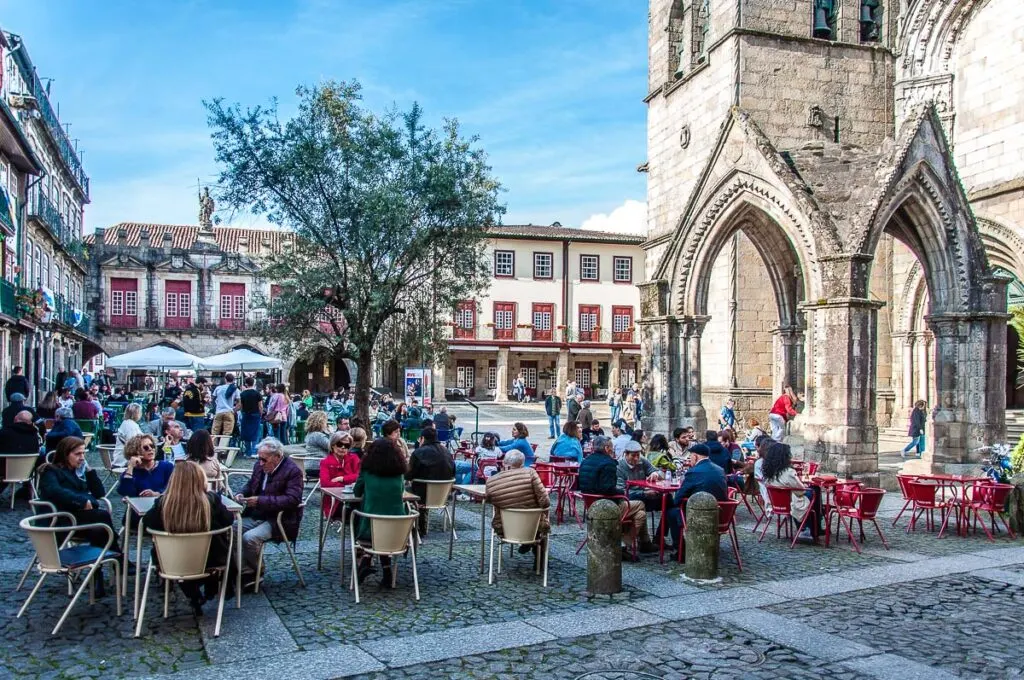
With a beautifully preserved medieval historic centre which is also a UNESCO World Heritage Site, Guimarães is an ever more popular destination to take a day trip or a weekend break in Portugal. About an hour away from the second-largest Portuguese city, Porto, Guimarães is easy to reach by road and railway.
So, in this blog post today, I want to share with you an easy to follow self-guided tour of Guimarães. It includes the city’s most well-known sights and landmarks – from the 10th-century castle which played a central role in the foundation of Portugal to the cool cable car which takes you to the top of the nearby Monte da Penha thus affording you fabulous panoramic views over the lush Portuguese countryside.
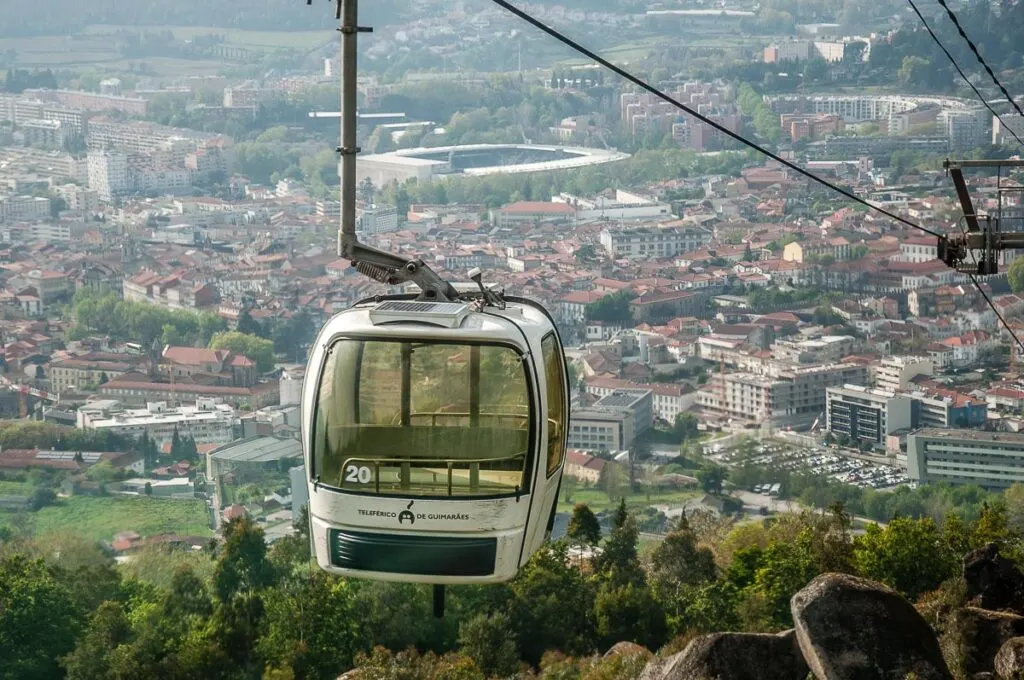
To make your travel planning an easy and enjoyable experience, at the end of this blog post I have also included lots of practical tips and a detailed map of the suggested itinerary. You can easily personalise it according to your needs and interests. There is also a short section about getting to Guimarães by train or car from anywhere in Portugal.
It’s all based on my personal experience of travelling to and exploring this beautiful Portuguese city. My last visit there was right before Easter in April of this year. This is the itinerary that I followed together with my family. It was my husband’s and my daughter’s first visit to Guimarães. I wanted to show them the best places there as I had gotten to know the city several years ago when I spent a couple of months there interning at a local radio station.
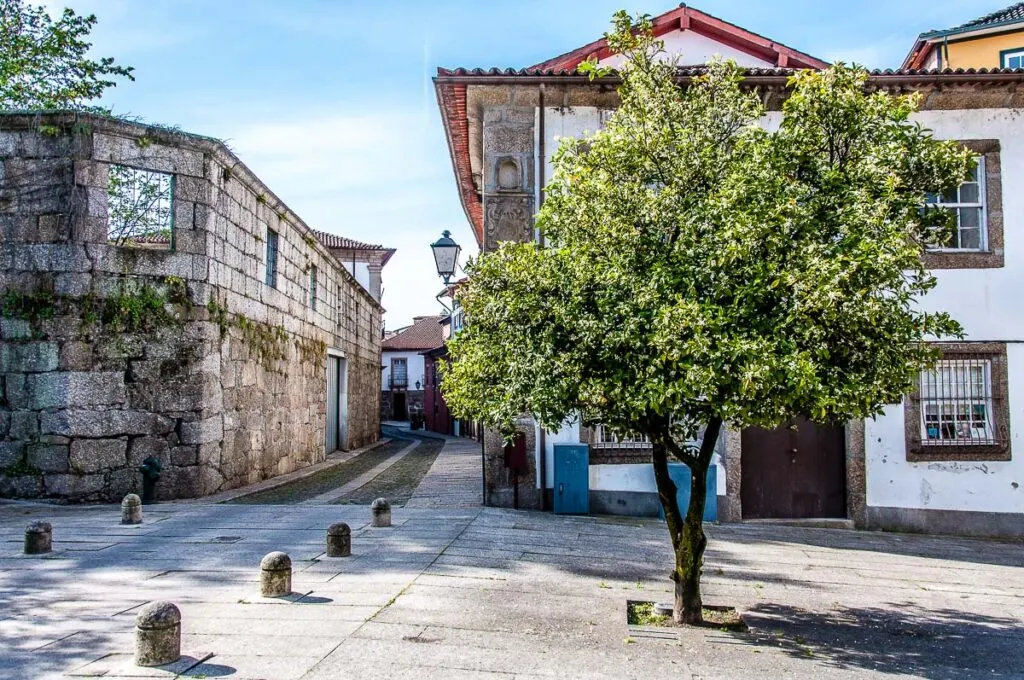
The itinerary covers a bit of history, some sightseeing, a number of hidden corners, many lovely views, delicious local specialities, and lots of walking interspersed with long moments of rest. So, there is something for everyone and for all types of interests – from history and art to good food and even a bit of hiking in the bosom of lush nature. Guimarães really delivers on all fronts.
To find out more about this exciting city in Northern Portugal, have a look also at this blog post:
Otherwise, let’s start!
Self-Guided Tour of Guimarães, Portugal – The Perfect Itinerary with Map, Practical Tips, and Travel Details
Pin for Later!
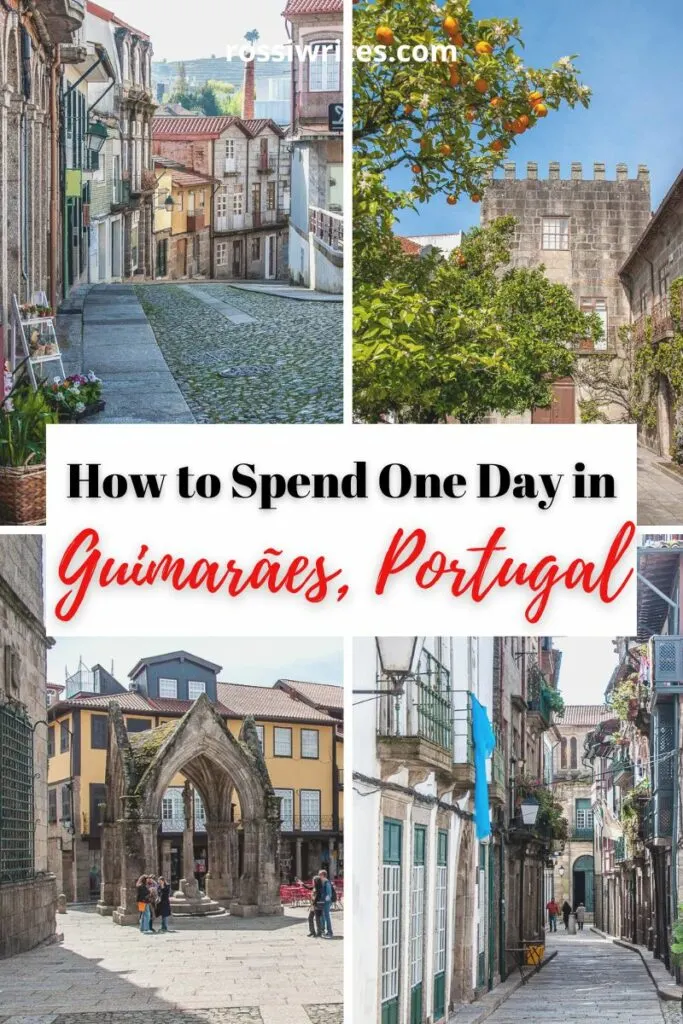

Start
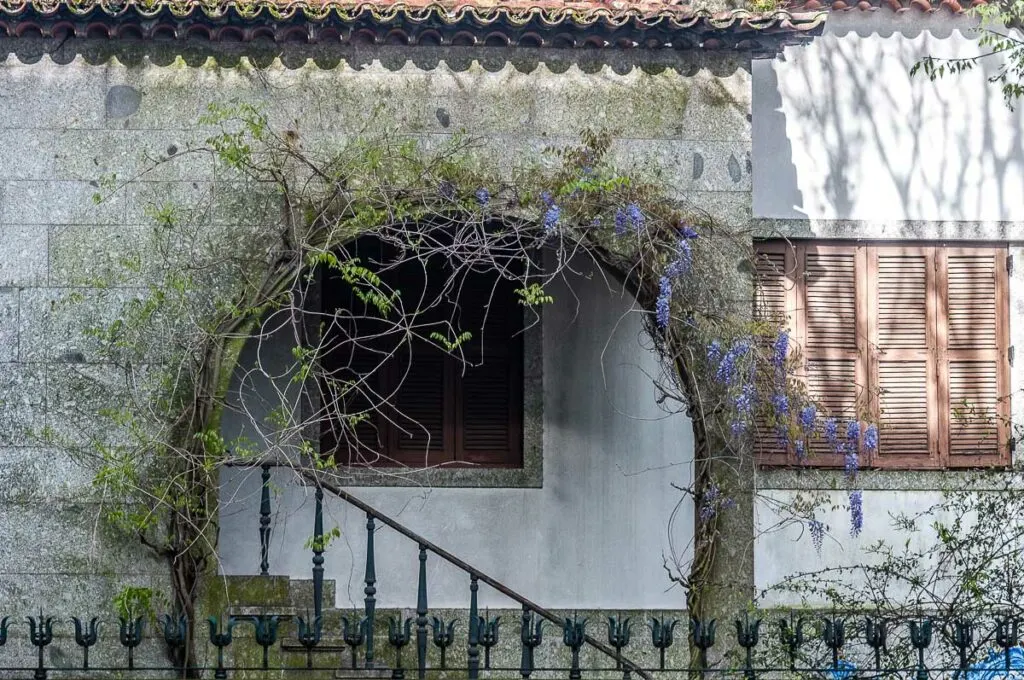
This one-day self-guided walking tour of Guimarães in Portugal starts from the city’s train station.
In case you are arriving by car, you can park for the whole day at the paid parking lot of Centro Cultural Vila Flor. It is just a few steps away from the train station, so you can join the itinerary without missing out on any sights.
Currently, it costs six euros to park there for the whole day (from 8 am to 8 pm). Click here to see the exact location of this parking lot on Google Maps. For alternative places to park in Guimarães, have a look at the website of the local provider Vitrus Ambiente. It’s in Portuguese, so you can use Google Translate to get an idea of the information.
If you don’t want to walk from the train station to the main cluster of sights on Colina Sagrada, then you can catch the bus. Line 004 will take you from bus stop Estação CP Guimarães (next to the train station) to Jardim do Carmo. You will miss out on the first few sights on the itinerary but you can still try to see them at a later stage.
The bus runs every 20 mins. The journey takes about 10-11 mins. You can download the most up-to-date bus timetable from this official link.
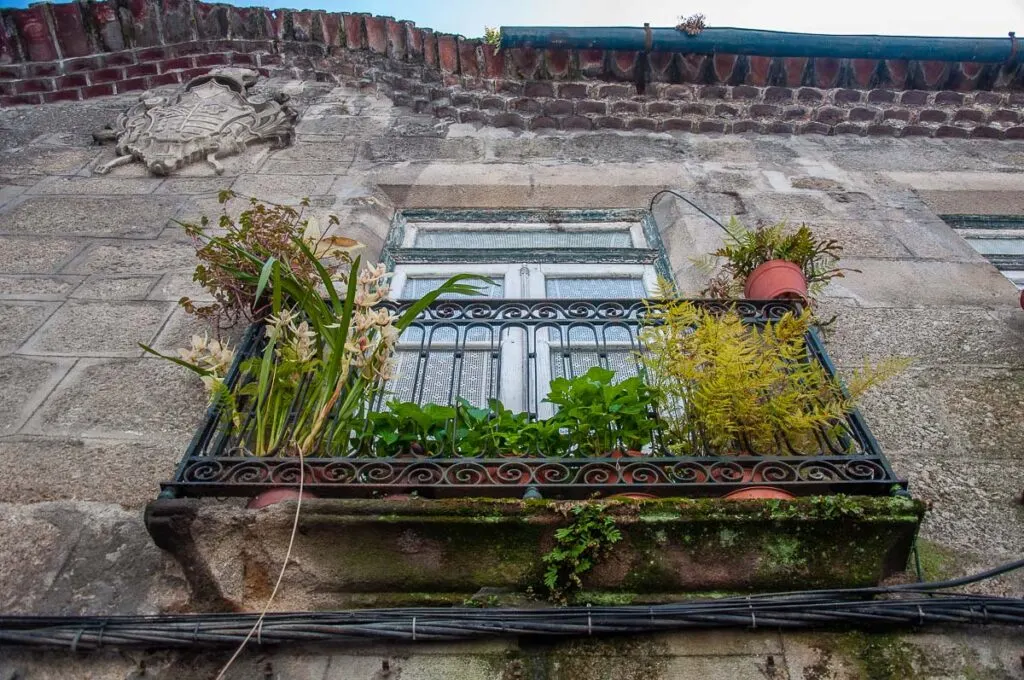
To make full use of this self-guided tour, aim to reach Guimarães around 9 am. Although small and compact, the city has many beautiful corners and you will want to see as much as possible for a truly memorable experience.
I haven’t assigned specific times of arrival and departure for each of the sights on this itinerary for Guimarães. It is up to you to decide how much time you want to spend at each and if you want to see them all or just a few.
You may even decide to spend the night in town and enjoy this self-guided walking tour of Guimarães over two days.
One final note. Bear in mind that Penha Cable Car has seasonal opening hours. During the low season, it remains closed for most of the week. If it doesn’t run on the day that you are in Guimarães then you can spend longer in each museum and other sights around the historic centre.
Otherwise, if you want to see it all and do it all, then you will need to be very strict in terms of organisation and time spent at each place around town.
From the Train Station to the Historic Centre of Guimarães
Guimarães’ train station is small and very easy to orientate yourself in. It stands on the long Avenida D. João IV and it’s about 10 mins away on foot from the city’s historic centre.
When you arrive, walk out of the train station and turn left (west). Follow Avenida D. João IV for about 120 m to the corner with Avenida D. Afonso Henriques (it will be on your right). Cross the street and continue down (north) Avenida D. Afonso Henriques for about 180 m.
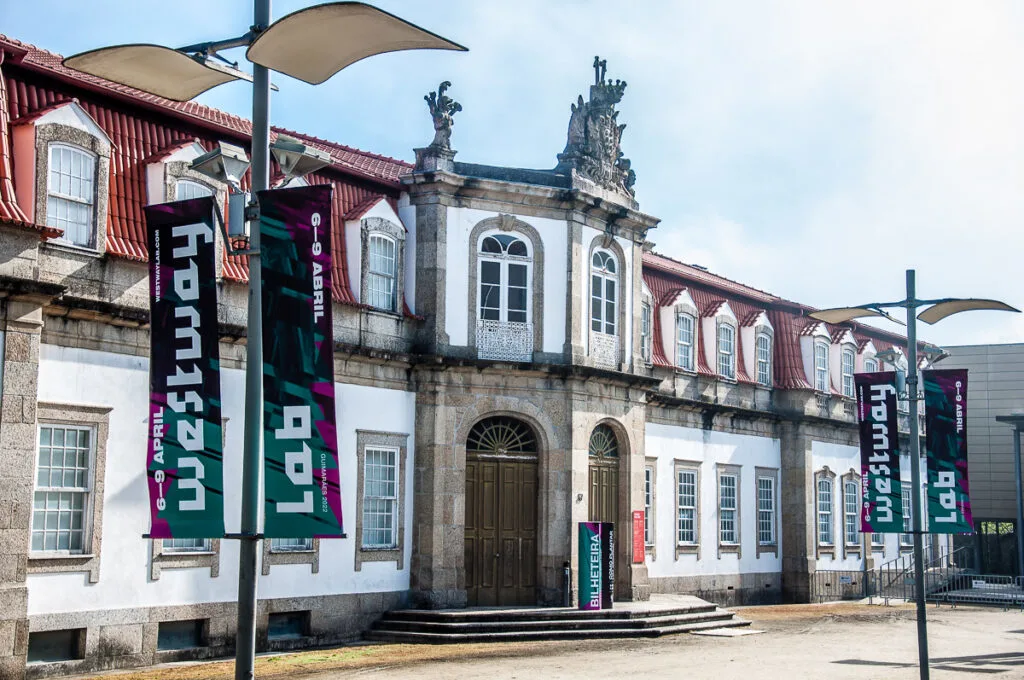
At this point, you will reach Centro Cultural Vila Flor. This is a sprawling villa with a lovely garden that functions as a cultural centre in Guimarães. Theatrical performances, musical events, and other happenings regularly take place here.
If you have arrived by car and have parked at Vila Flor, then you can begin this self-guided walking tour of Guimarães from this point onwards.
As this is an already packed one-day tour of Guimarães, Vila Flor is simply a walk-past point on the itinerary. You can see its garden through the fence as you pass by. If you have decided to spend the night in town, though, you can always check the current listings and return to Vila Flor for an evening performance.
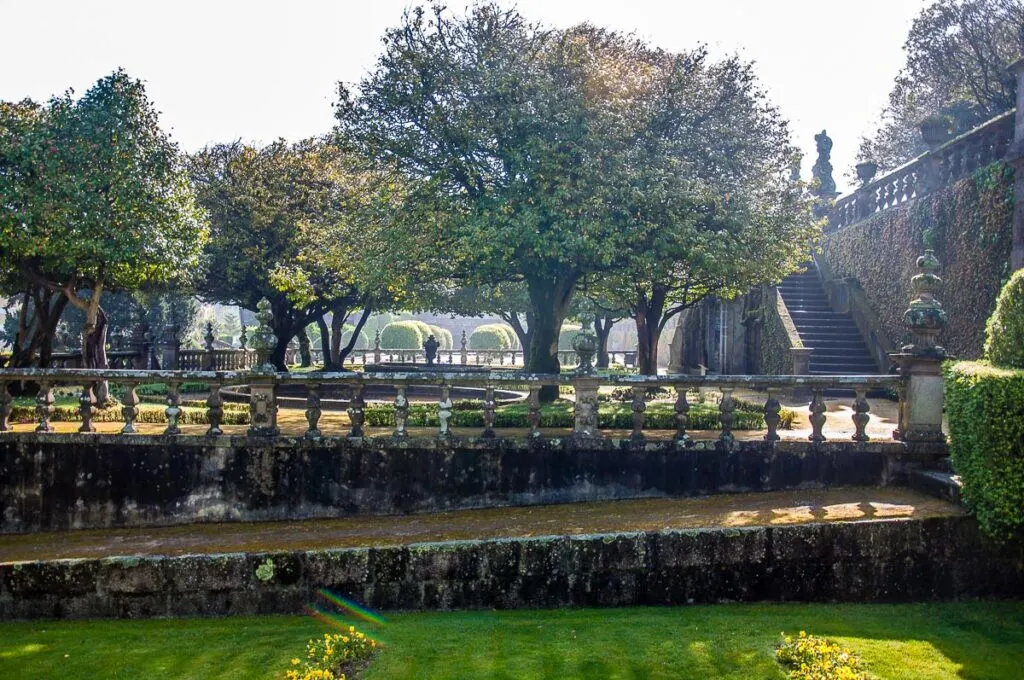
Continue straight down Avenida D. Afonso Henriques. This is a residential area of Guimarães with lots of large blocks of flats. There is not much to see here but it’s a nice and slow way to ease yourself into the calm and relaxing atmosphere of the city.
After about 350 m, you will reach Largo Bernardo Moreira de Sá. On the right, stands a small garden – Jardim Público da Alameda. Instead, turn to the left, walk up the street for about 50 m or so, cross the street, and on your left-hand side, there will be a large square – Largo do Toural.
Largo do Toural and Archaeological Museum
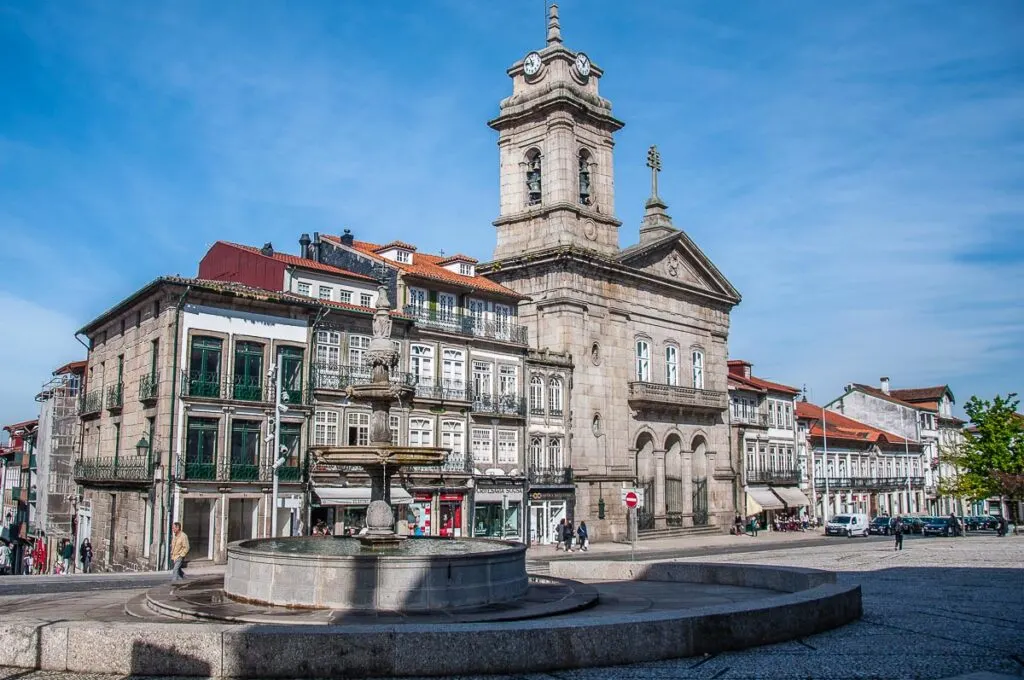
This is Largo do Toural – a central square in Guimarães that serves as a gateway to the city’s medieval historic centre. It has a large fountain at its heart and it’s flanked by the Church of São Pedro on one side and by a long wall of tall buildings on the other.
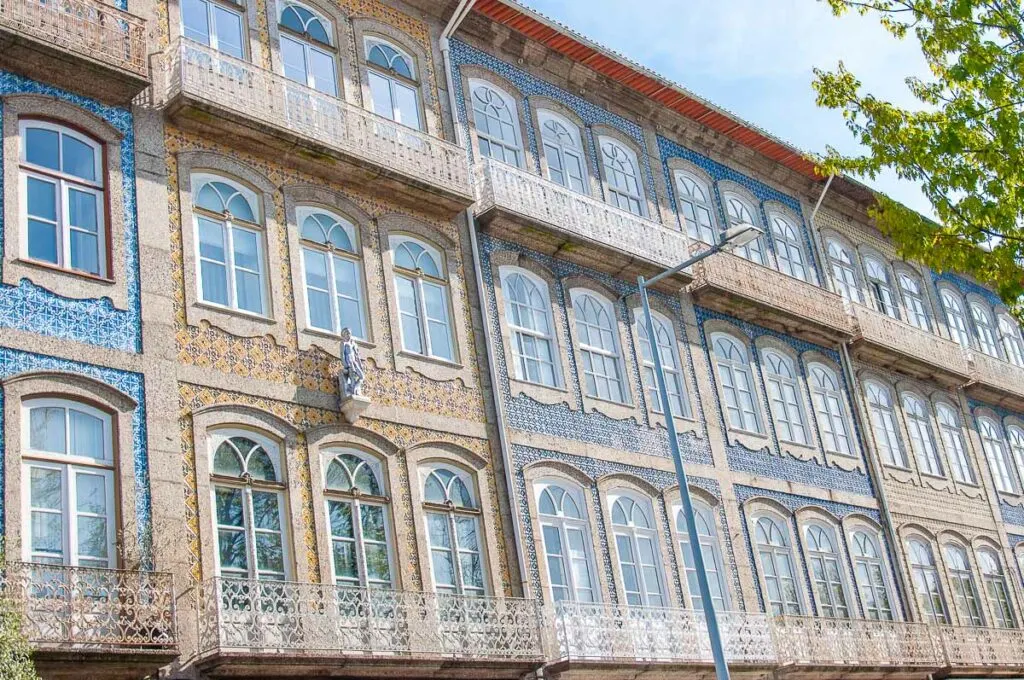
Their facades seem to be composed of endless lines of elongated windows. The narrow strips of wall between and underneath the windows are covered with the traditional Portuguese tiles, called azulejos. All this gives Largo do Toural a very elegant look and feel.
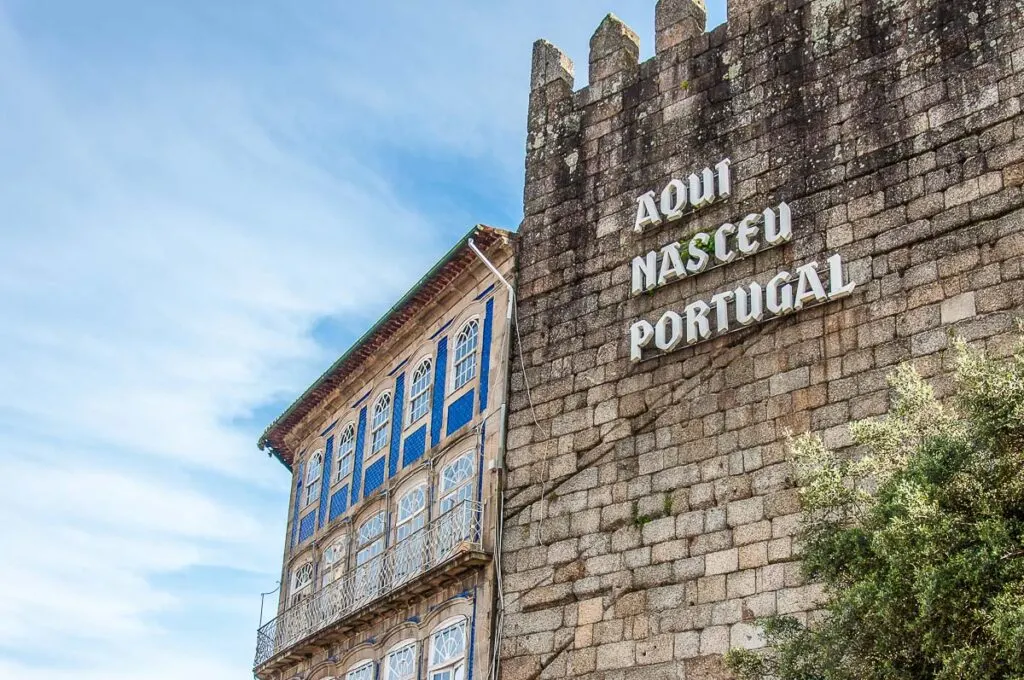
It is at this square that you will see the emblematic sign Aqui nasceu Portugal (in English, Portugal Was Born Here). It is affixed to a portion of the medieval defensive wall and proudly proclaims the fact that indeed in the first half of the 12th century it was precisely in the city of Guimarães that the County of Portucale became the independent Kingdom of Portugal.
Small eateries and traditional shops stand around Largo do Toural. It’s a good place to stop and get breakfast or a snack, coffee and water. There are also several pharmacies here in case you need something last-minute like hand gel or tissues.
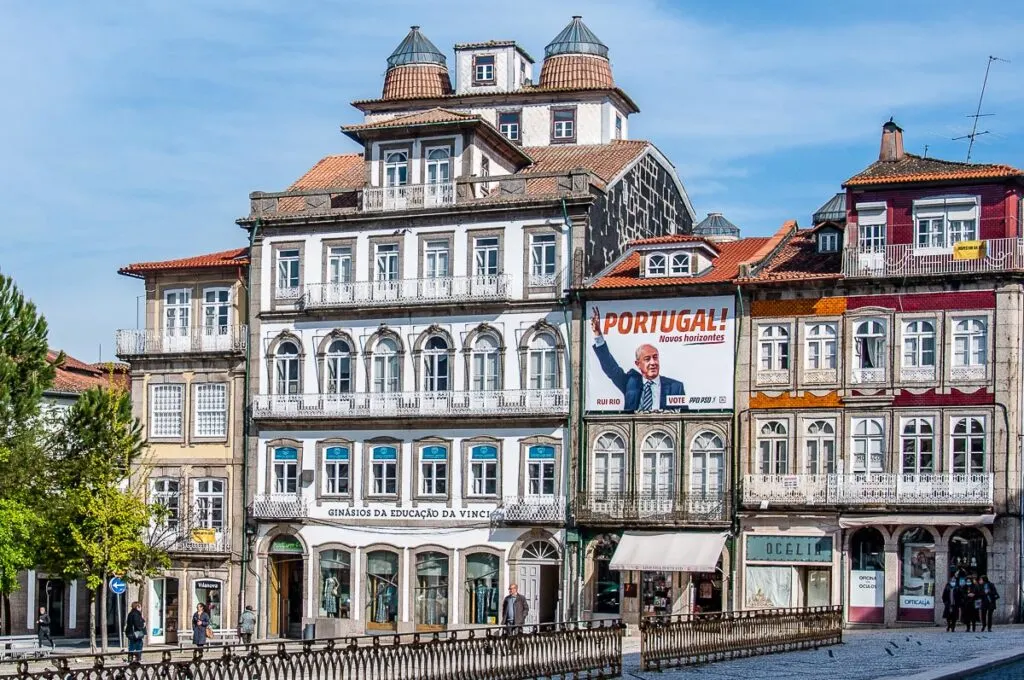
Once these practicalities of travel have been sorted, head to the Museum of the Martins Sarmento Society. This is the oldest archaeological museum in Portugal. You will find it on Rua Paio Galvão, 2 which is 120 m down the road from the north end of Largo do Toural.
The museum is housed in a beautiful neoclassical building and it also incorporates the Gothic cloister of the former Monastery of São Domingos. Expect a rich collection of thousands of Celtic and Roman artefacts. The focus is on the findings made during the excavations of Citânia de Briteiros. This is a Celtic hill-fort that was occupied by different cultures up to the Middle Ages. It’s about 15 km away by car from Guimarães.
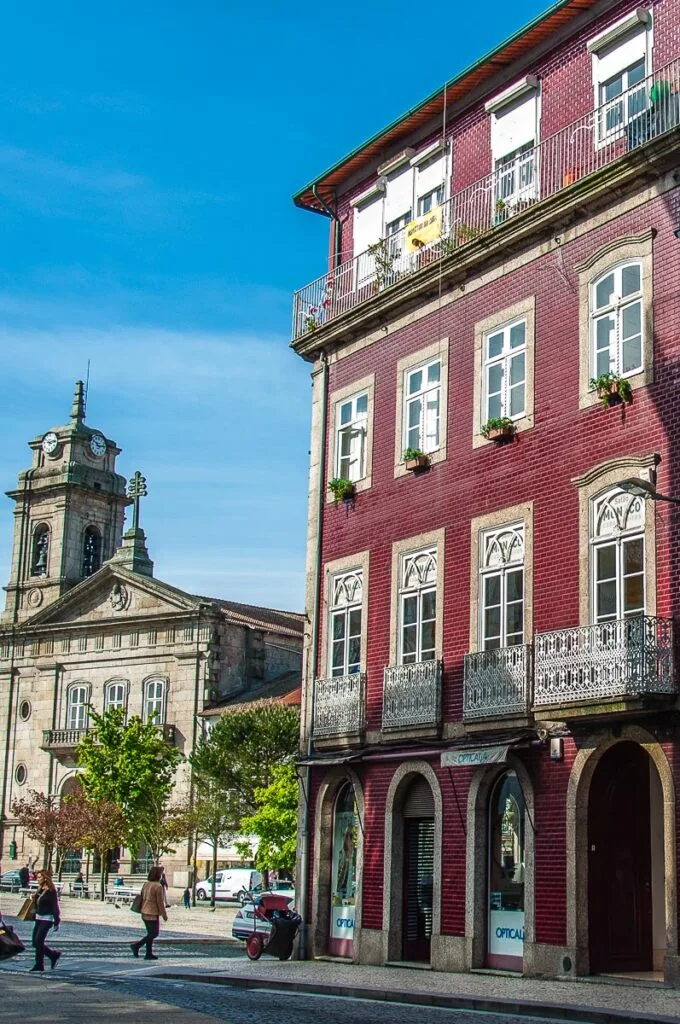
After visiting the museum, it’s time to enter the historic centre. Retrace your steps to the north end of Largo do Toural. Once there, follow Rua de Santo António. This long street is flanked by fancy boutiques and azulejo-covered facades.
Now, that you are entering the historic centre of Guimarães, you will notice houses and buildings in many different styles. They beautifully reflect the passage of the centuries and the architectural changes that each one of them brought.
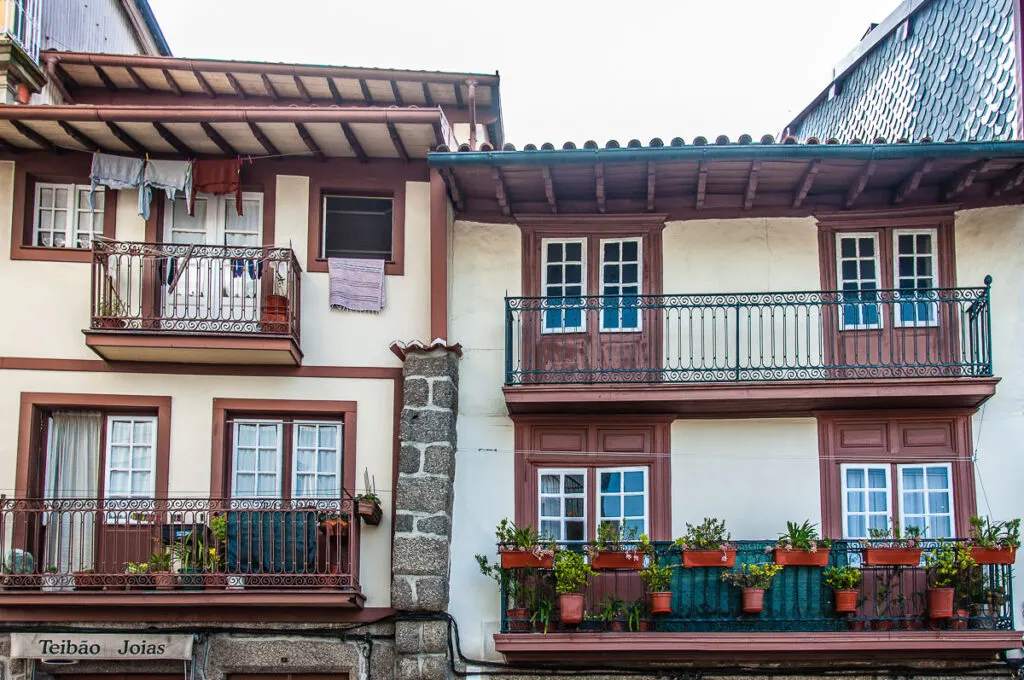
It’s quite enjoyable to walk slowly just taking it all in. The small balconies with wrought-iron railings, the blooming potted plants, the cobbled lanes. It is quite magical!
Walk north-east on the Rua de Santo António for about 110 m. Then turn right onto Rua Val de Donas and after 30 m turn left to stay on the same street. Continue for about 130 m and you will reach one of the prettiest hidden gems of Guimarães – Largo dos Laranjais.
Largo dos Laranjais and Jardim do Carmo
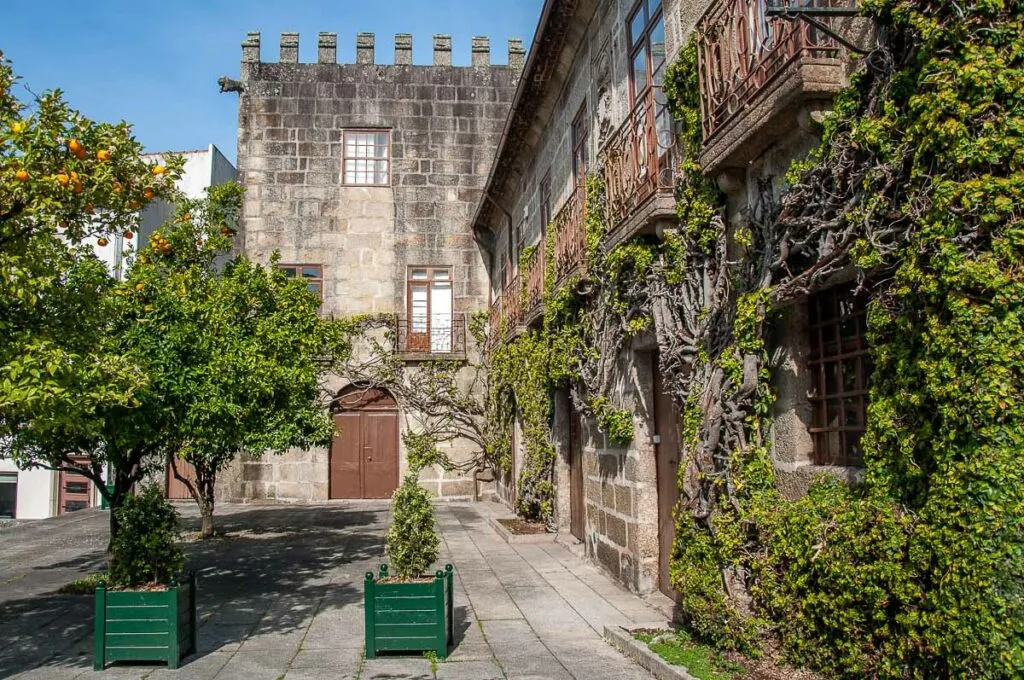
Largo dos Laranjais or the Square of the Orange Trees is a small rectangular piazza overlooked by a tall medieval tower. At its heart, stand a few orange trees covered with exuberant blossoms and dripping with ripe fruit.
It’s a very pretty scene! The fragrant blossoms fill the air with their heady scent attracting a bunch of buzzing bees. Take a moment to take it all in and then head up to the nearby Jardim do Carmo. It’s only about two minutes away.

So, from the top end of Largo dos Laranjais turn left onto Rua João Lopes de Faria and after 13 metres or so continue on Rua das Trinas for 80 m. Then turn right onto Rua Agostinho Barbosa for seven metres and just across the street you will see a pretty green space – Jardim do Carmo. It has steps leading up to a circular fountain at its top end.
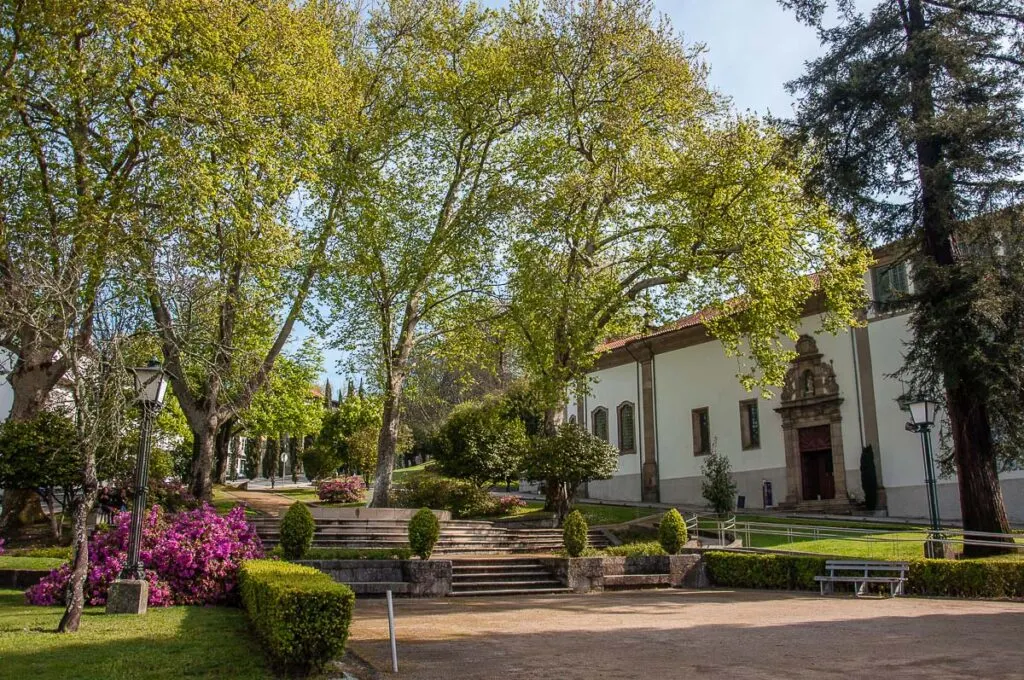
The Igreja of Nossa Senhora do Carmo (in English, Church of Our Lady of Carmel) stands on the right-hand side of this delightful garden.
Small and with a white facade decorated with a lovely azulejo panel, the church dates back to the end of the 17th century. Built in the Baroque style, it has a beautifully frescoed choir and a striking main altar decorated with the typical for Portugal gilded wooden carvings in an elaborate, florid style.
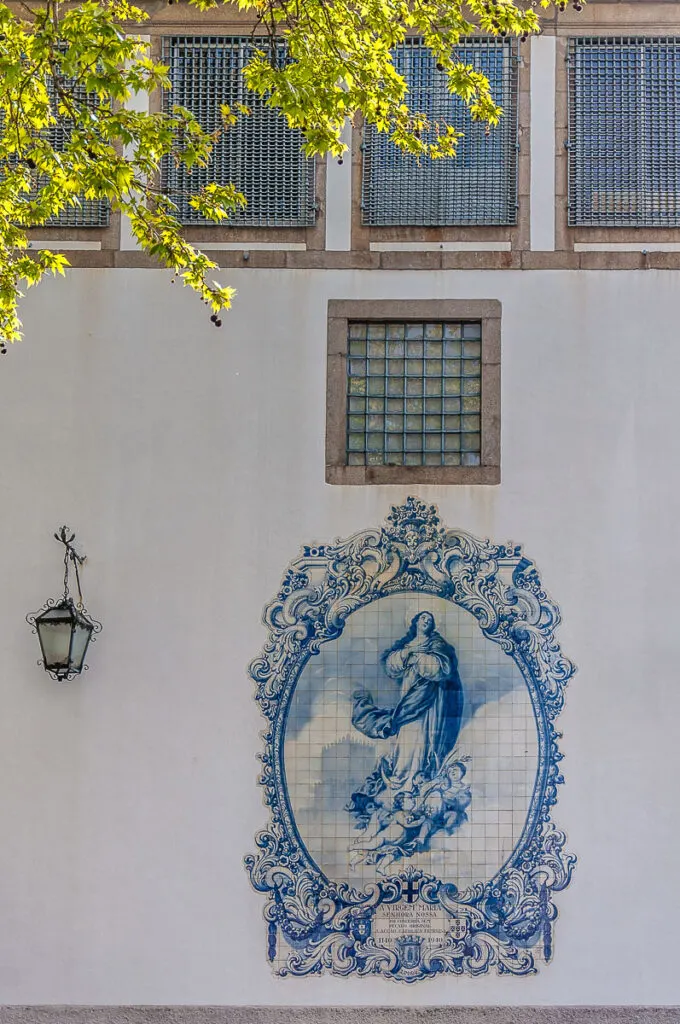
Stopping for a short moment either in the garden or the church is a lovely thing to do and gives you a moment of respite before beginning the ascent to Portugal’s Sacred Hill.
Colina Sagrada
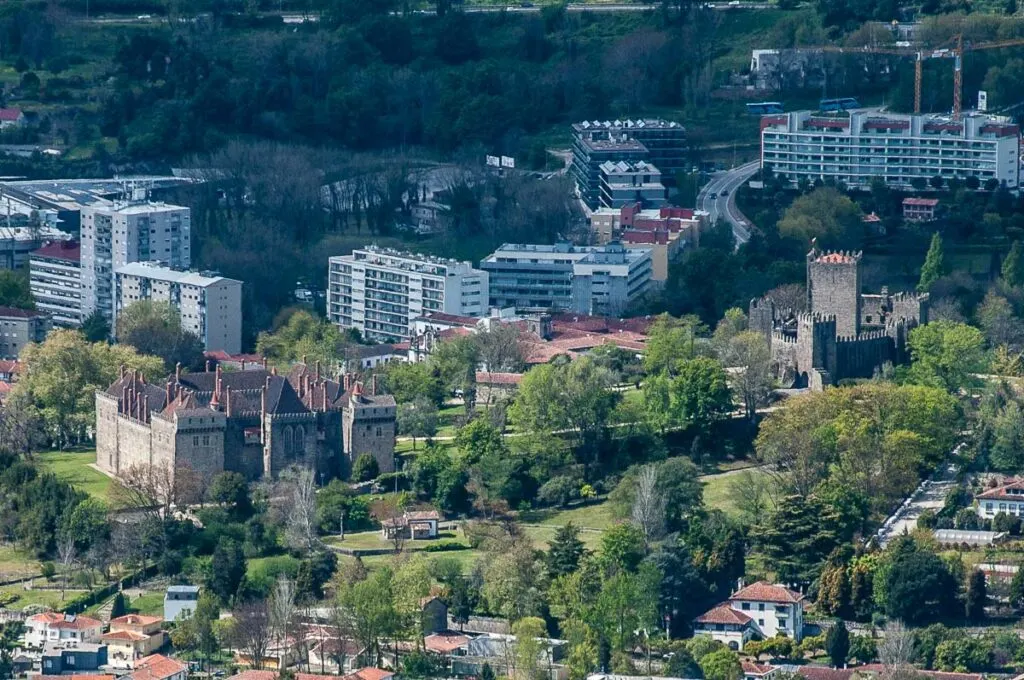
Starting from the Church of Nossa Senhora do Carmo, walk in a straight line uphill for about 200 m. You will reach the base of the small hill Monte Latito which is also widely known as Colina Sagrada – the Sacred Hill of Portugal.
Here, within a few steps from one another, you can visit four iconic for the country landmarks:
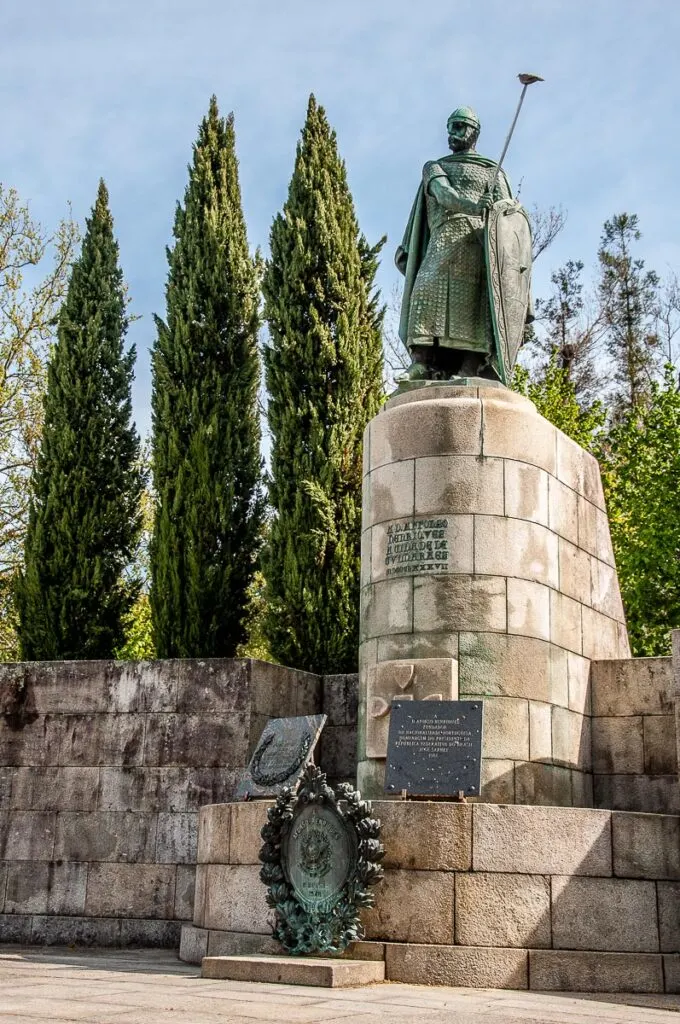
Statue of D. Afonso Henriques – this is the imposing statue of the founder of Portugal. Cast in bronze in 1887, it’s the work of the renowned Portuguese sculptor Antonio Soares dos Reis.
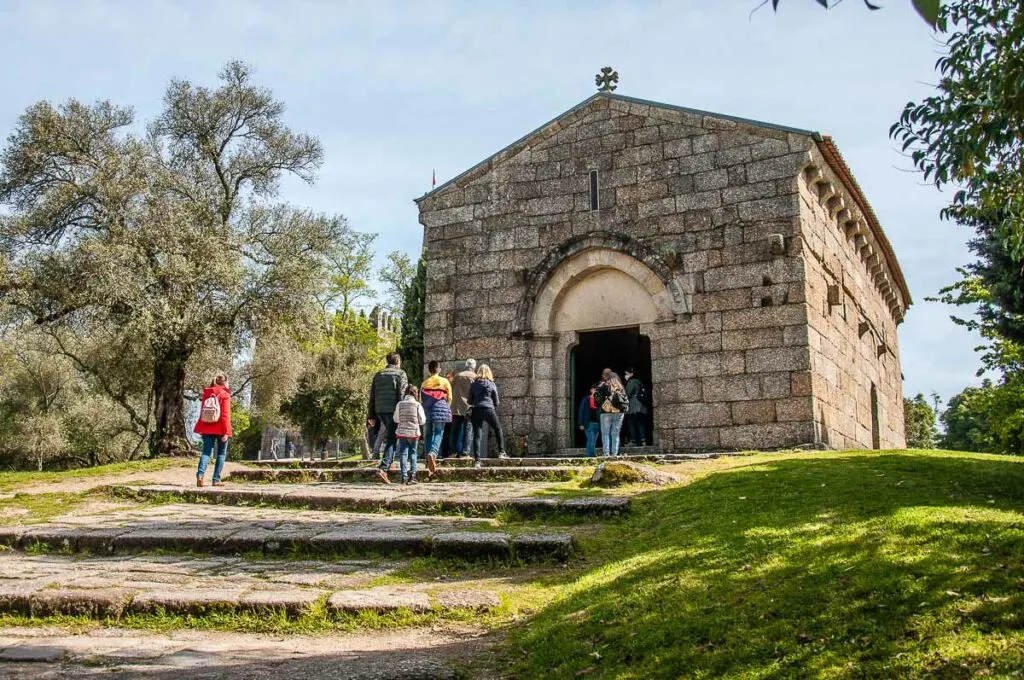
Church of São Miguel do Castelo – a tiny Romanesque church where D. Afonso Henriques, allegedly, was baptised in his infancy. The original baptismal font is preserved inside the otherwise bare church.
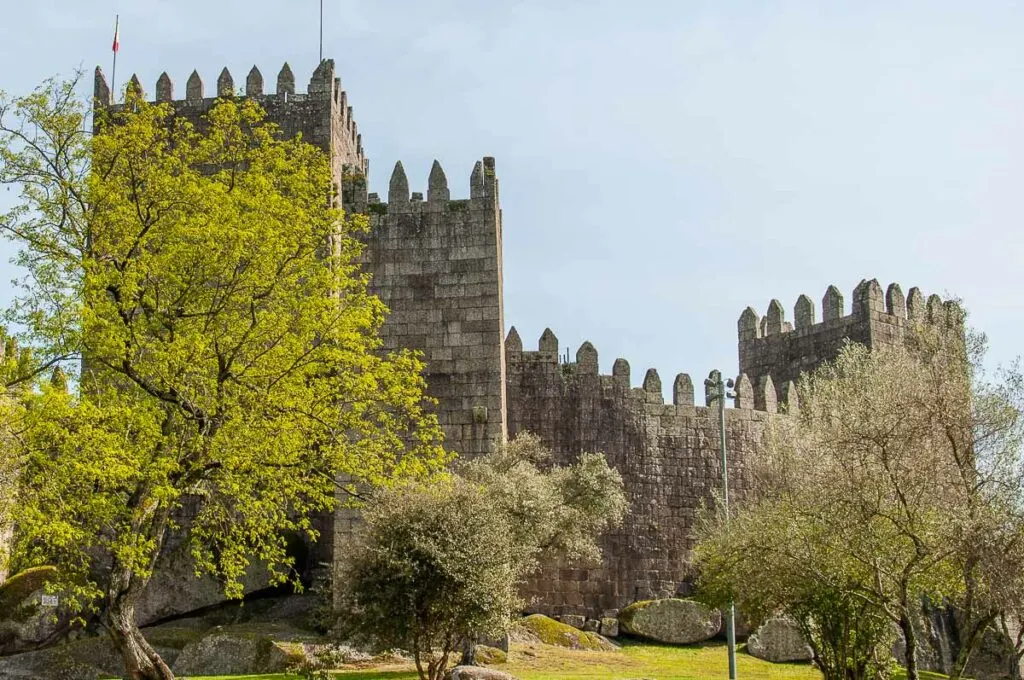
Castle of Guimarães – a proud medieval fortification first erected in the 10th century. It played a prominent role in the establishment of Portugal as an independent country in the first half of the 12th century. Many historians state that D. Afonso Henriques was born here as his parents – the Counts of Portucale – used the castle and Guimarães as their base.
Nowadays, the Castle of Guimarães is recognised as one of the Seven Wonders of Portugal. In other words, it’s one of the country’s most important cultural and historic monuments.
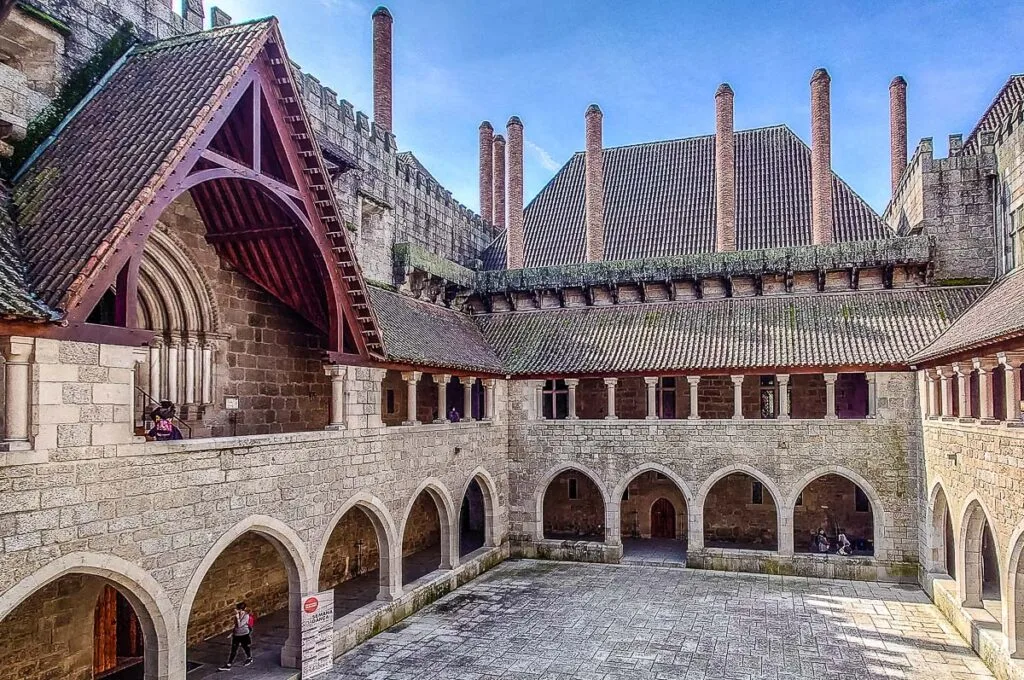
Paço dos Duques de Bragança – a heavily restored 15th-century palace first built by Afonso de Barcelos. He was an illegitimate son of King João I of Portugal and founder of the Bragança dynasty of emperors, kings, princes, and dukes.
These are the most important historic sights to see in Guimarães. Even if you don’t have time for anything else in this beautiful Portuguese city, a visit to the Colina Sagrada should top all travel wish lists for it.
Ideally, explore the four sights in the order I have listed them. However, it’s best to decide in situ depending on the number of tourists and the weather. You can buy a combined ticket for the castle and the palace or the castle, the palace, and the Alberto Sampaio Museum in town. Click to check the current prices.
The Colina Sagrada is a lush, green place with many different types of trees and shrubs. You can relax in their shadows or go for a short walk around if you can spare a few moments here before heading back downtown.
Rua de Santa Maria
Once you have ticked off the sights on Colina Sagrada, head back downtown. For this, start from the Paço dos Duques de Bragança and walk about 200 m downhill past the Church of Nossa Senhora do Carmo. At the bottom of Jardim do Carmo, cross Rua Serpa Pinto and start walking down Rua de Santa Maria.
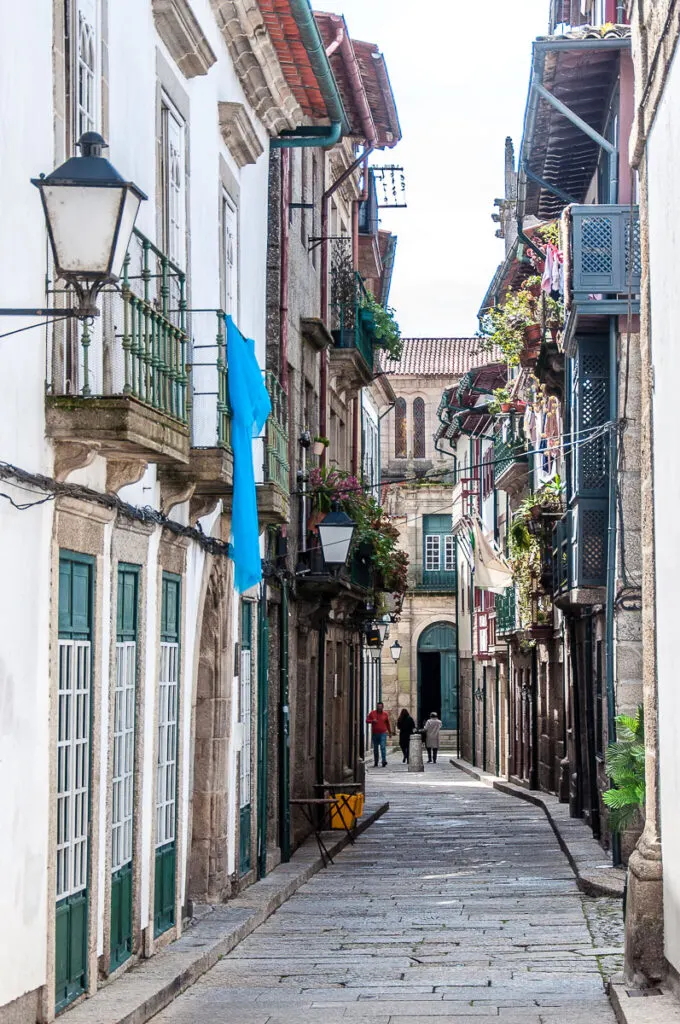
Dedicated to St. Mary, this long street is hundreds of years old. When it was first laid out in the Middle Ages, it connected the Castle of Guimarães to an important convent which stood in the heart of what nowadays is the city’s historic centre.
Along the length of Rua de Santa Maria, you will see several beautiful historic buildings and quirky shops selling handmade souvenirs.
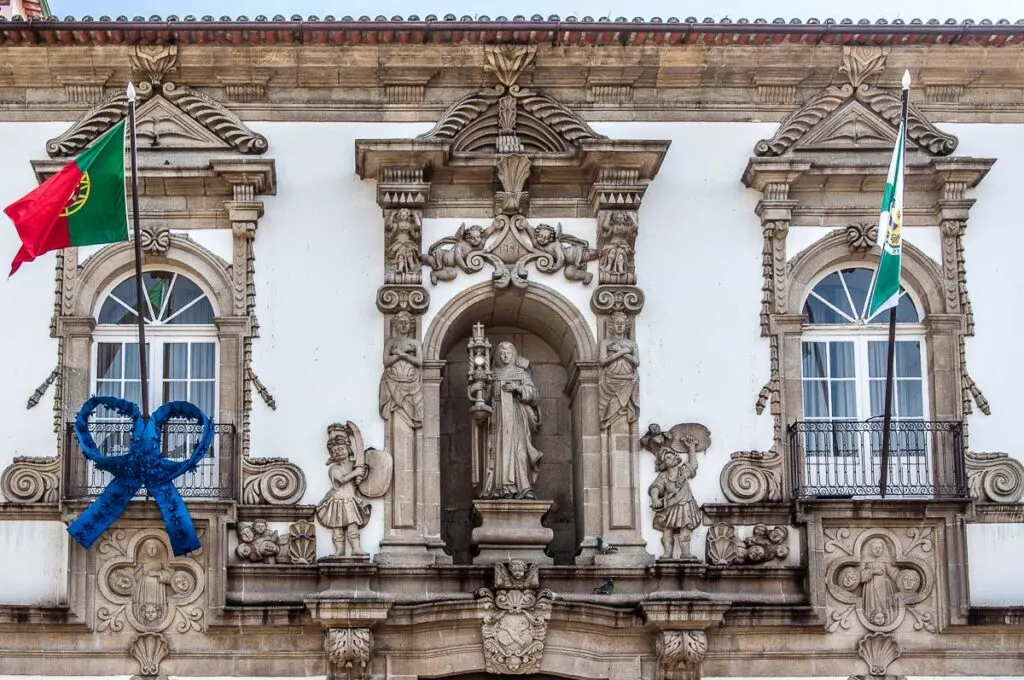
Keep an eye out for the Town Hall of Guimarães. Formerly a rich convent dedicated to Santa Clara, you will recognise it by its ornated Baroque facade.

It’s also on this street that you can taste the famous pastries and sweets of Guimarães: toucinho-do-céu, tortas de Guimarães, and douradinhas de Guimarães. They are handmade following centuries-old convent recipes. Pop into Divina Gula right next to the historic Casa do Arco and take your pick.
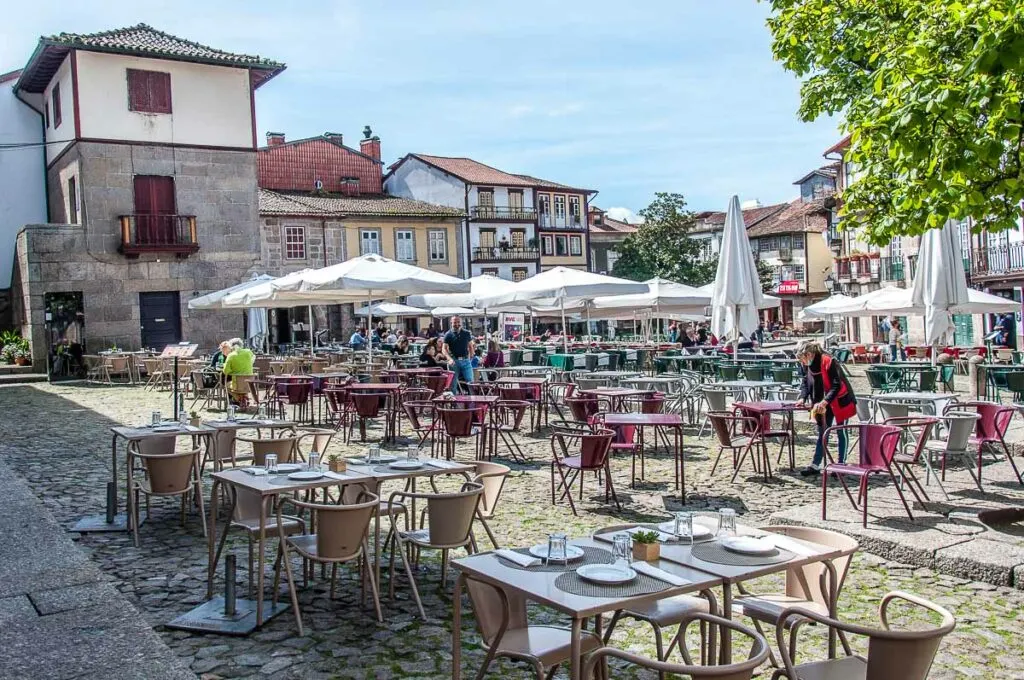
A few steps further downhill, Rua da Santa Maria will take you to one of the most picturesque historic squares in Guimarães. Praça de São Tiago is a dream of colourful facades surrounding a cobbled square peppered with the tables of the local restaurants.
You can stop here for lunch if you want. My suggestion is to hold on for just a little bit longer and walk across to Largo da Oliveira – easily, the most beautiful place in Guimarães.
Largo Da Oliveira
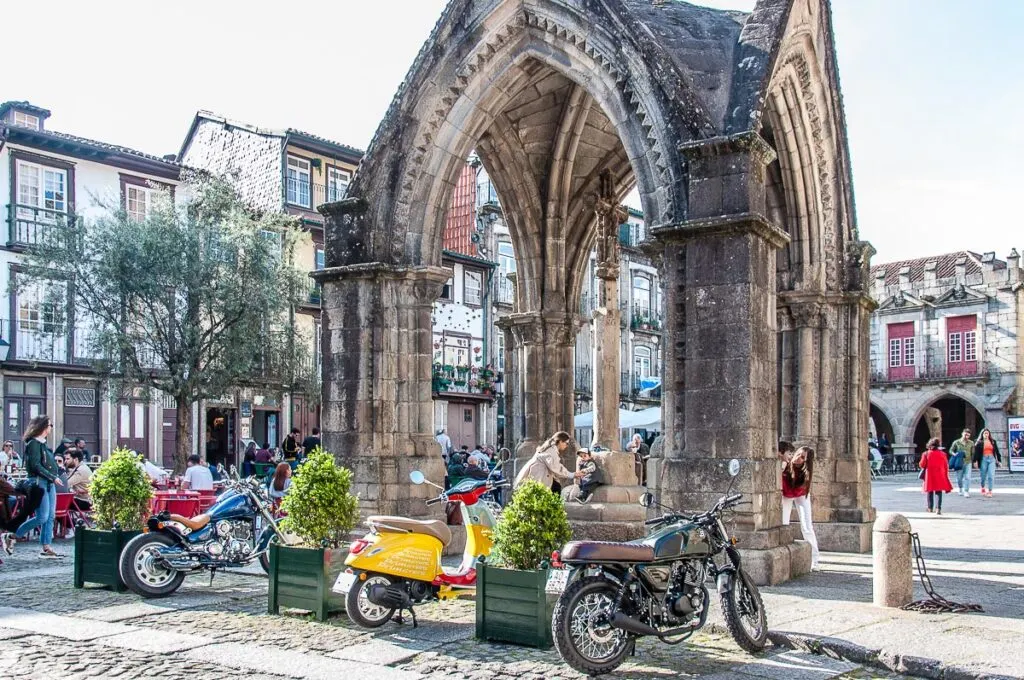
Largo da Oliveira or the Square of the Olive Tree is a small stone-paved square that seems plucked out of a medieval fairytale. It’s here that you will see many of the city’s most historic buildings and yet the square has a young and exciting vibe to it.
Dotted with the tables of many local eateries, you can sit for a bite to eat while taking in the beautiful surroundings and feeling lucky for simply being here.
Here is a shortlist of the most important sights to see on Largo da Oliveira:
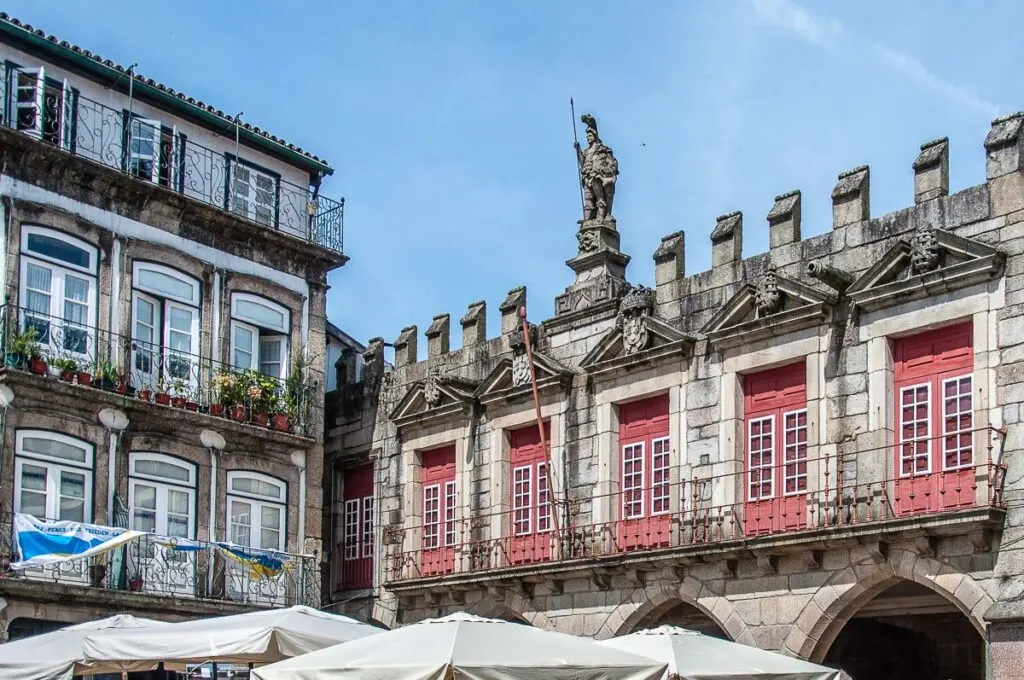
Antigos Paços do Concelho – standing above the vaulted arcade that separates Praça de São Tiago from Largo da Oliveira, this is the city’s medieval town hall. It was built between the 14th and the 15th centuries and it’s crowned by the statue of a warrior.
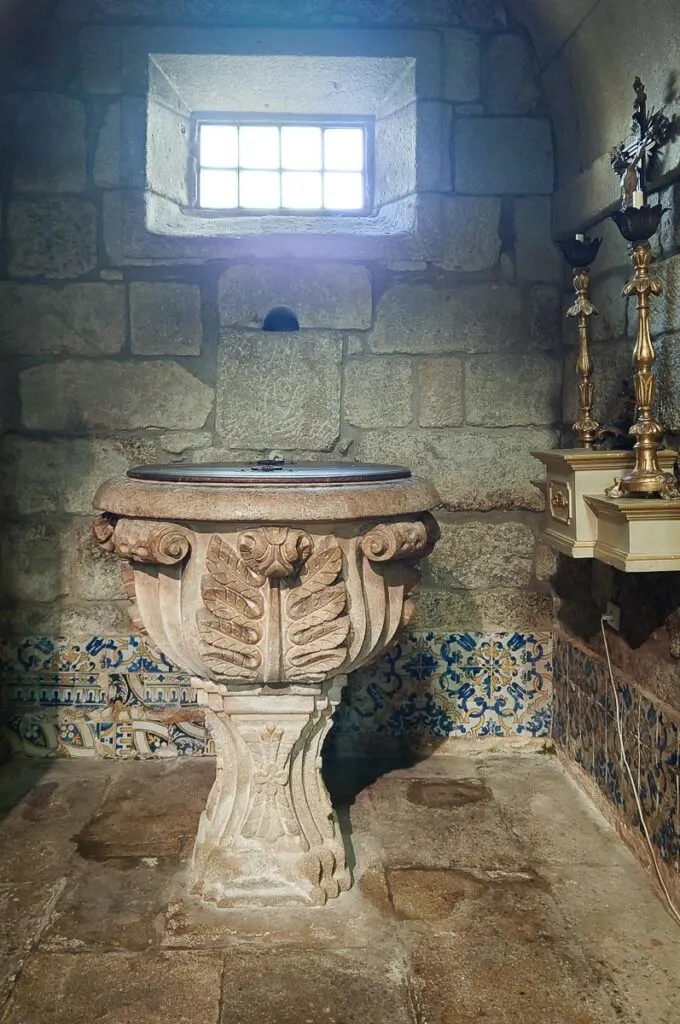
Church of Nossa Senhora da Oliveira – with a history that stretches back to the 10th century, this is one of the oldest churches in Guimarães. During the Middle Ages, it was an important place of prayer and religious pilgrimage.
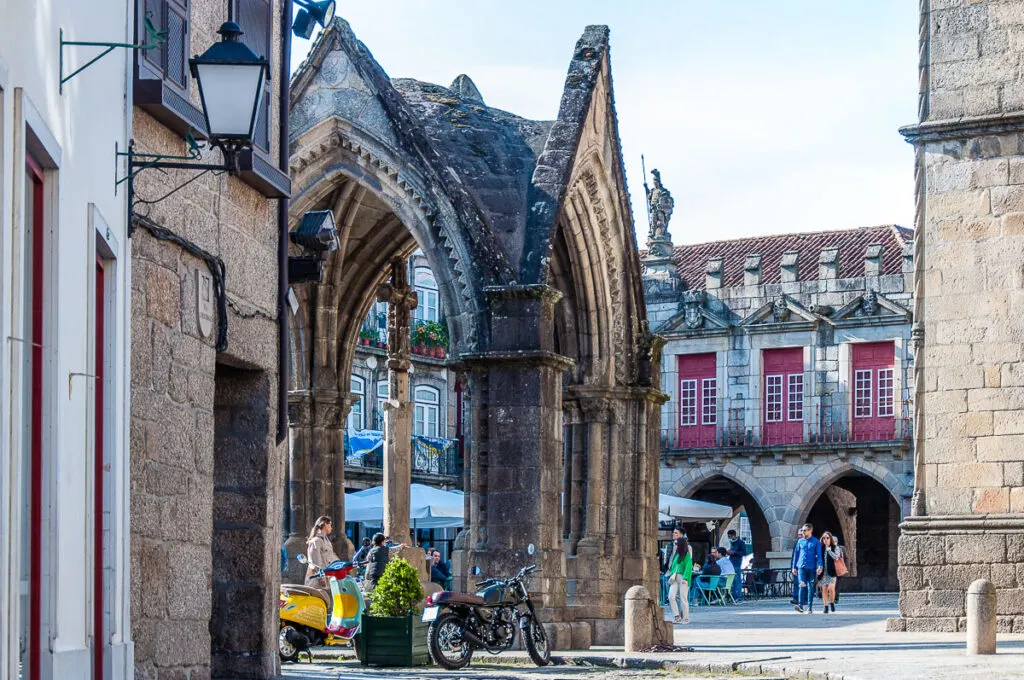
Padrão do Salado – a 14th-century arched monument covering a raised cross. It was erected in commemoration of the Battle of Rio Salado in 1340 when the armies of Spain and Portugal stopped the invasion of the Iberian peninsula by the then sultan of Morocco.
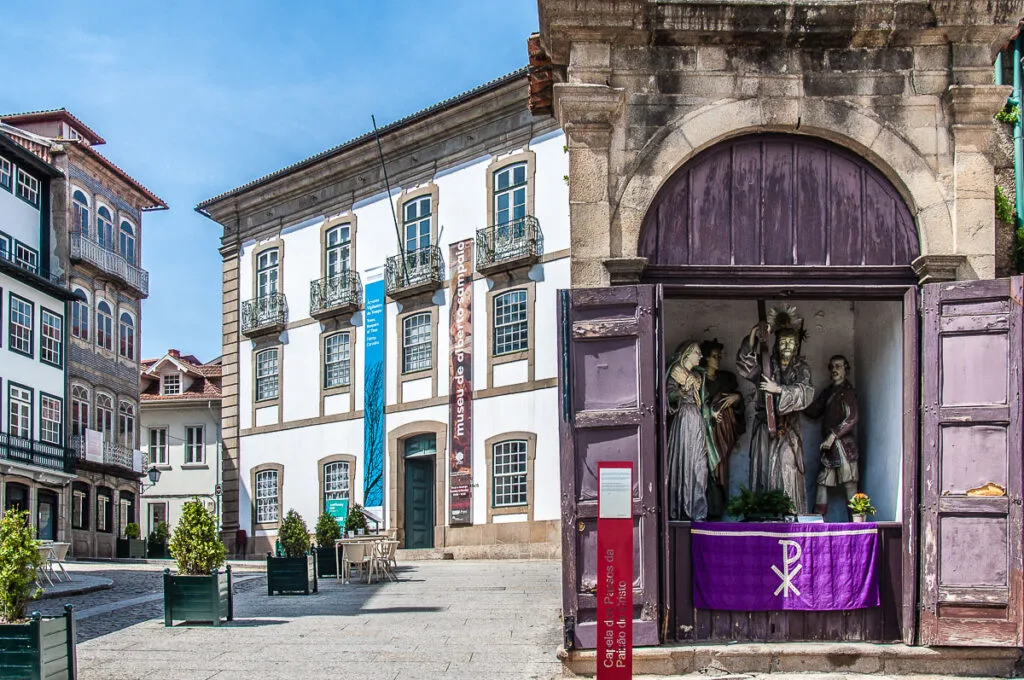
Alberto Sampaio Museum – founded in 1928, it’s housed in three spaces – Chapter House, Cloister, and Priory – that once belonged to the adjacent Church of Nossa Senhora da Oliveira. Inside, the museum has eight rooms and several thematic clusters with objects dating from the 12th to the 19th centuries. Bear in mind that the entrance of the museum is on Rua Alfredo Guimarães just around the corner from the Padrão do Salado.
Between having a relaxed lunch and taking in the sights and facades around Largo da Oliveira, you can easily spend a couple of hours in this enchanted corner of Guimarães. However, this small Portuguese city has even more surprises up its sleeve, so it’s time to continue our tour and head to Jardim do Largo da República do Brasil.
Jardim do Largo da República do Brasil
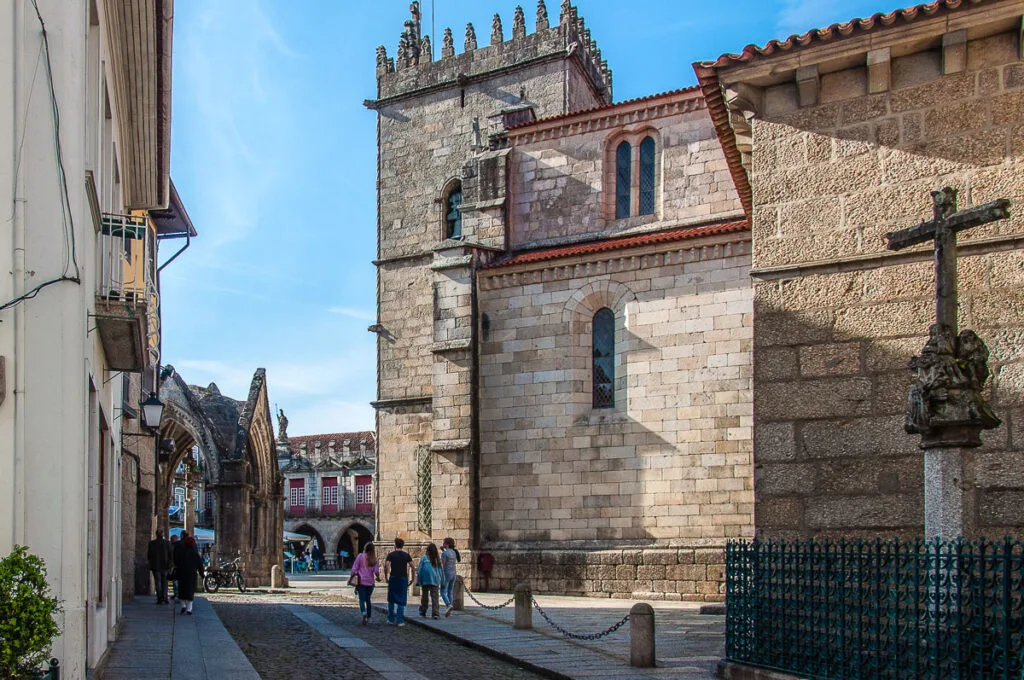
Leave Largo da Oliveira behind by walking down Rua Alfredo Guimarães for about 100 m. This small street is flanked by imposing buildings and opens onto a large boulevard.
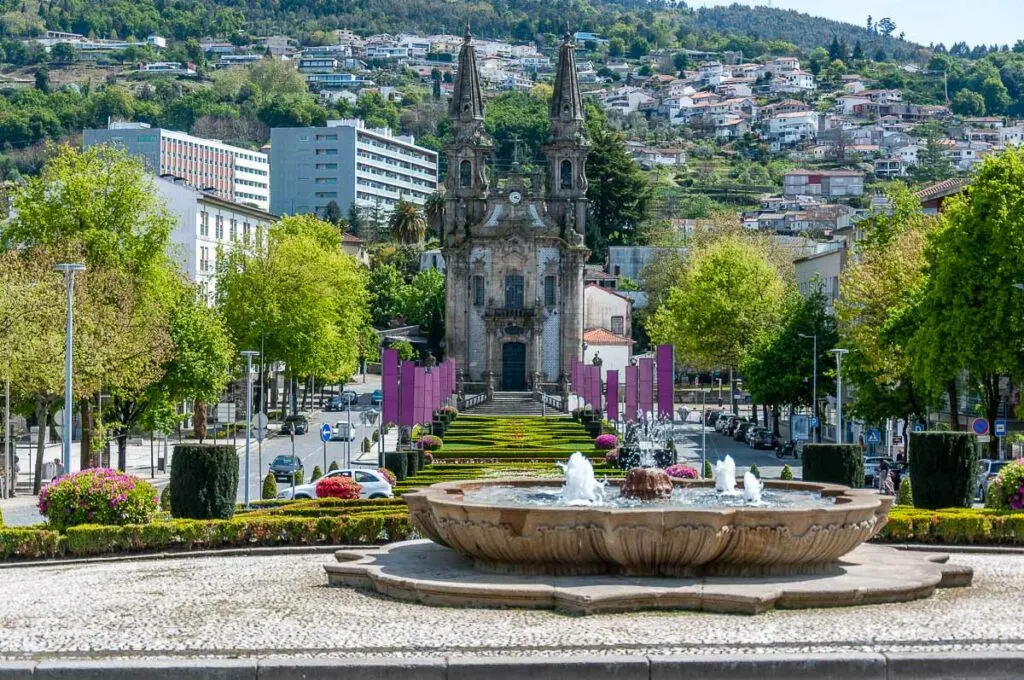
Right across the boulevard, you will see one of the most imposing views in Guimarães – that of the perfectly landscaped garden of Largo da República do Brasil. With an eruption of seasonal blooms contained between geometrical lines formed by beautifully trimmed shrubs, the garden leads the eye down to a thin tall church dating back to the 18th century.
Its full name is the Igreja e Oratórios da Nossa Senhora da Consolação e Santos Passos (in English, Church and Oratories of Our Lady of Consolation and Sacred Chapels). Walk the 250 m from the fountain of the garden of Largo da República do Brasil to the church.
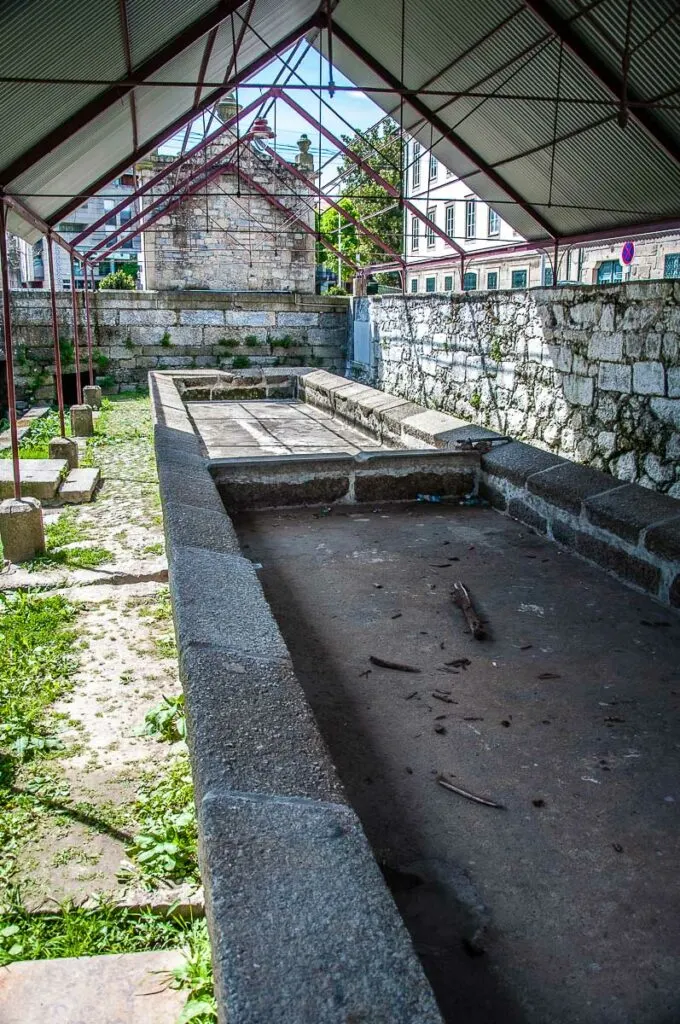
Along the way, you will pass by a small square – Largo Conde de Arnoso – with the large water fountain known as Fonte do Campo da Feira. Behind it, you can see the city’s 19th-century lavoir or communal wash-house. Nowadays, it looks quite abandoned but it’s a curious spot to glimpse as you walk past.
If the church is open, you can pop in for a quick visit. If time is pressing, however, head straight to Penha Cable Car – the next stop on this one-day self-guided tour of the city of Guimarães in Portugal.
Penha Cable Car
The distance from the Igreja e Oratórios da Nossa Senhora da Consolação e Santos Passos to Penha Cable Car (also known as Teleférico de Guimarães) is about 450 m. From Largo de São Brás turn right onto Rua Dr. Ricardo Marques. After 74 m, turn right onto Rua do Rei Pegu. Walk straight for 190 m. Take a slight left across Jardim do Lugar das Hortas and after about 100 m or so you will see the station of Penha Cable Car.
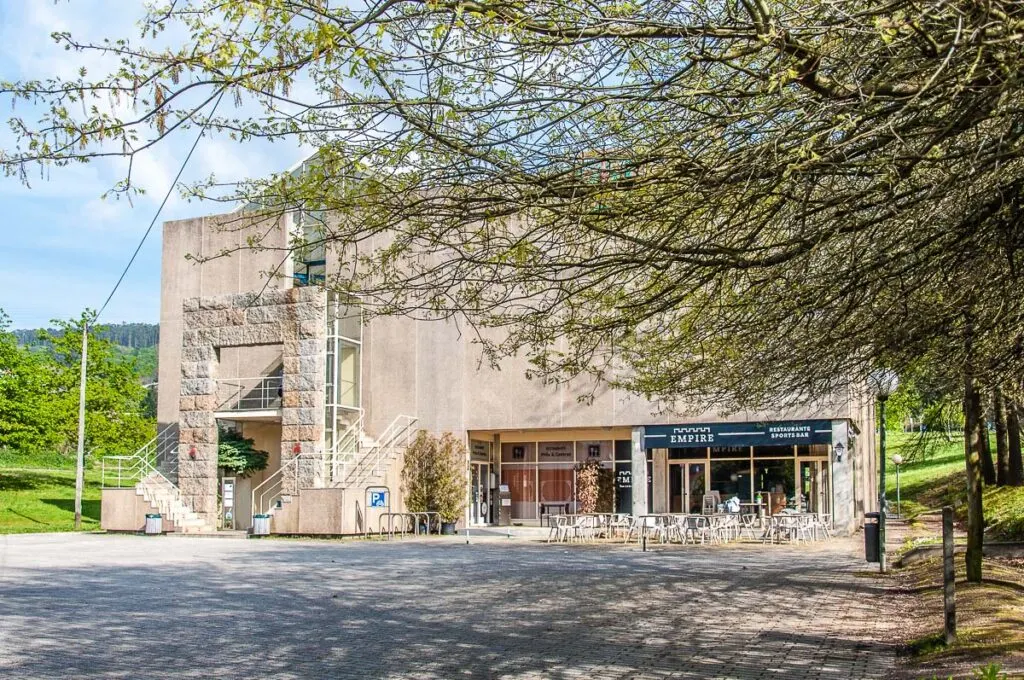
They say that this is the oldest cable car in Portugal. It’s been in use since 1995. Its cabins are quite small and the entrance door is rather narrow. You board while the cabins continue slowly moving forward. So, be mindful of loose clothing and keep your bag in front of you to make it easier to walk in.
As mentioned above, Penha Cable Car has seasonal opening hours. While it operates every day during the high season, during the low season it remains closed for most of the week. Check its Facebook page for up to date information.
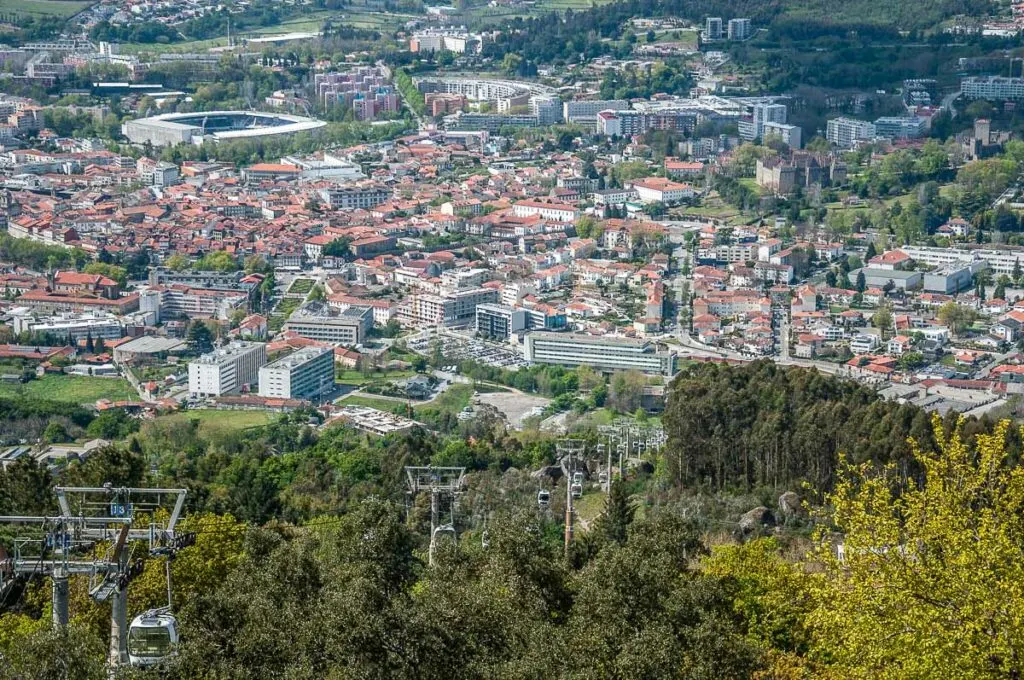
If you are taking a day trip to Guimarães from Porto, you can buy a combined ticket for the train and the cable car from Porto’s São Bento railway station. This will save you a few euros compared to buying the tickets individually.
Penha Cable Car will take you to the top of Monte da Penha at 617 m in height. The journey stretches over 1,500 m and takes a few minutes.
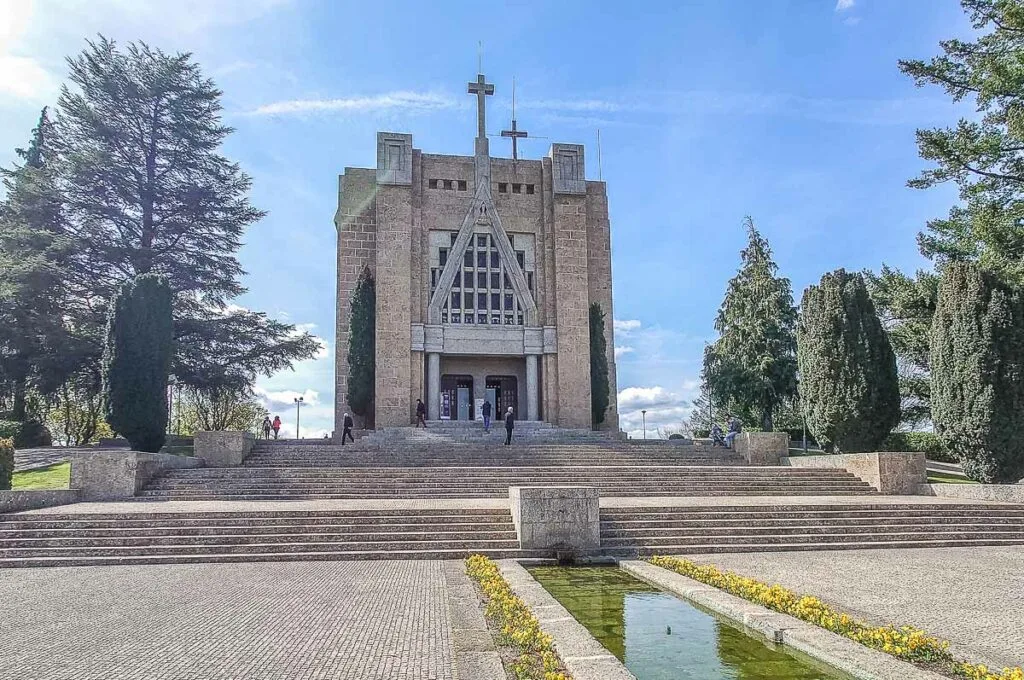
As you are nearing the top station of the cable car, you will spot the Sanctuary of Penha. Built between the 1930s and the 1940s, it’s quite modernist in style but well worth a visit.
Around the sanctuary, there is a lovely nature park with hiking paths, picnic areas, panoramic viewpoints, grottoes, monuments, and even a camping area. The most impressive thing here are the enormous mossy boulders that are dotted all over the place as if thrown by the hand of a giant.
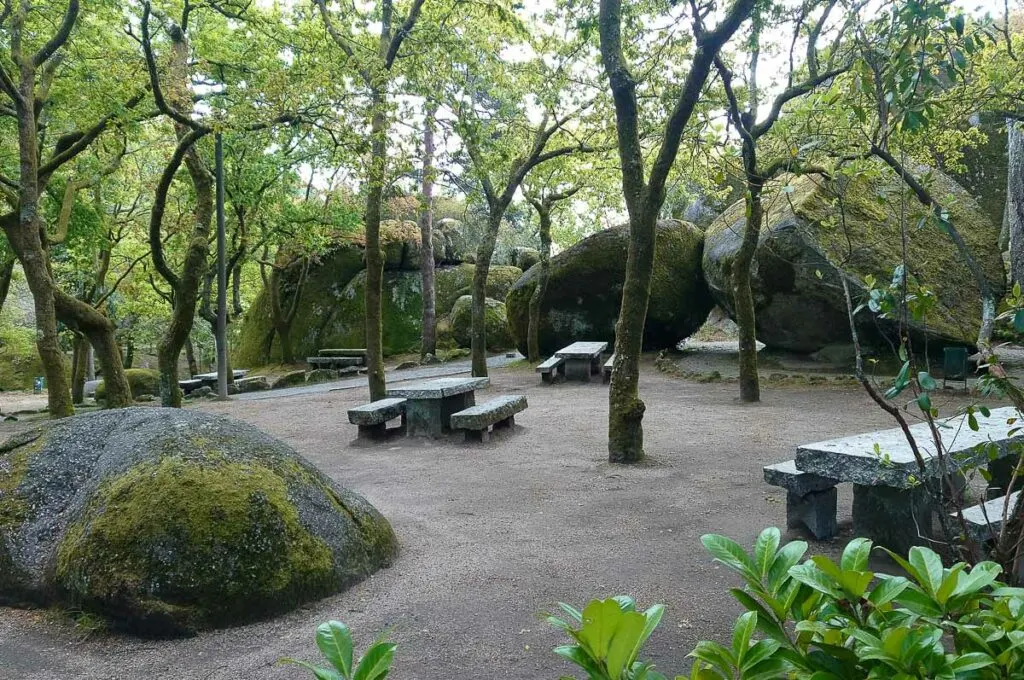
The hilltop park of Monte da Penha is a great place to visit on a day trip to Guimarães. On a hot day and after all the sightseeing around the historic centre, you can escape to the park and relax in the shadow of the trees while taking in the splendid views.
You can then head back down to the city via a return journey on Penha Cable Car.
Church of São Francisco and Tanques dos Couros
It’s time to tackle the last two stops on this self-guided tour of the city of Guimarães in Portugal. It’s been a very long and exciting day. So, if you are really tired you can skip this portion of the itinerary and walk straight back to the train station or the parking lot at Centro Cultural Vila Flor. It’s about 20 mins on foot (1.3 km) from Penha Cable Car to the train station.
In fact, this is exactly what we did on our visit to Guimarães as a family. All three of us were tired and replete with impressions after a wonderful day spent in this lovely Portuguese city. So, after a nice hike and a relaxing picnic on Monte da Penha, we decided to take the train back to Porto in the very late afternoon instead of waiting until it got dark in the evening.
So, this final step on the itinerary is based on my previous stay in Guimarães several years ago. If you still have some energy left and have been quick in ticking off all the other sights on this one-day itinerary, head to the Church of São Francisco.
It stands about 650 m or eight minutes away from the lower station of Penha Cable Car. First, walk back to the Igreja e Oratórios da Nossa Senhora da Consolação e Santos Passos. This should take around five minutes.
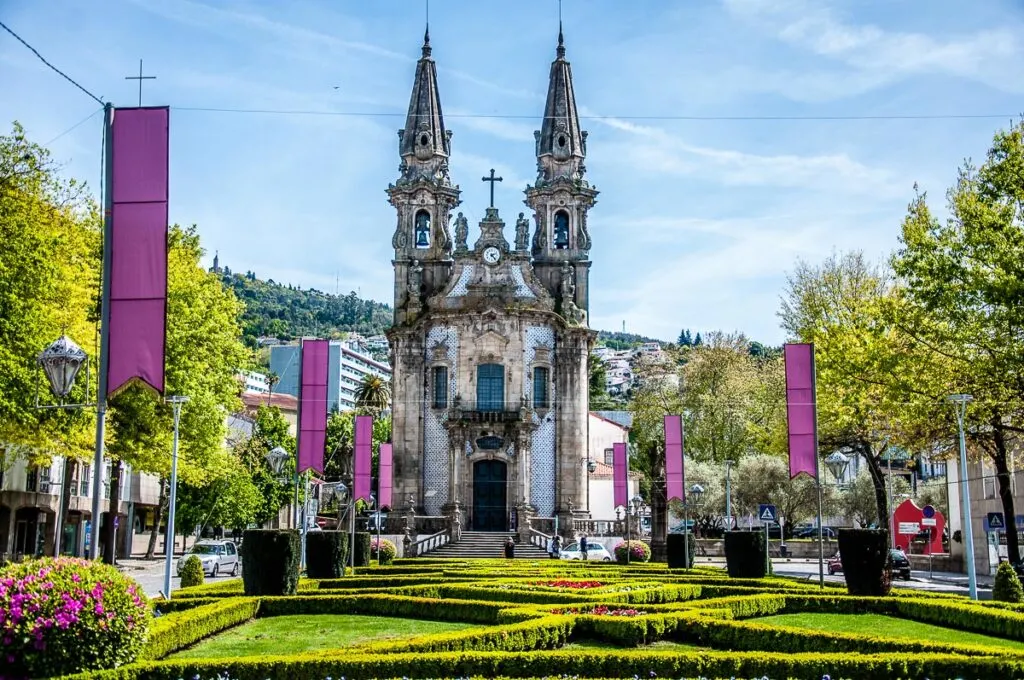
Once in front of the church, continue straight onto Largo da República do Brasil for about 70 m. Then turn left onto Rua Padre Gaspar Roriz and walk for 120 m.
Now, you should see the vast building of the Church of São Francisco. Inside you can admire splendid azulejos in blue and white as well as intricate wood carvings painstakingly covered with gold leaf.
Just bear in mind that the Church of São Francisco usually closes at 5 pm. If you want to see its beautiful interiors, you’ll need to be very expedient in visiting the other sights on this one-day itinerary of Guimarães.
There is one last sight to tick off – the historic tanneries or Tanques dos Couros as they are known in Portuguese. These are large granite tanks that for many centuries were used to tan animal hides. This was a very profitable business for the city and it led to the development of the local footwear factories. To this day, the shoes produced in Guimarães are considered some of the best in Portugal.
The historic tanneries are about 350 m or four minutes away from the Church of São Francisco. To reach them, walk west on Largo de São Francisco towards Alameda de São Dâmaso for about 40 m. Then, turn left onto Alameda de São Dâmaso and follow this large boulevard for about 140 m.
Take a sharp left onto Largo do Trovador and walk for 60 m. Largo do Trovador turns right and becomes Rua de São Francisco. Walk on it for 100 m. Turn right onto Largo do Cidade and you will see the tannery tanks.
Back to the Train Station of Guimarães
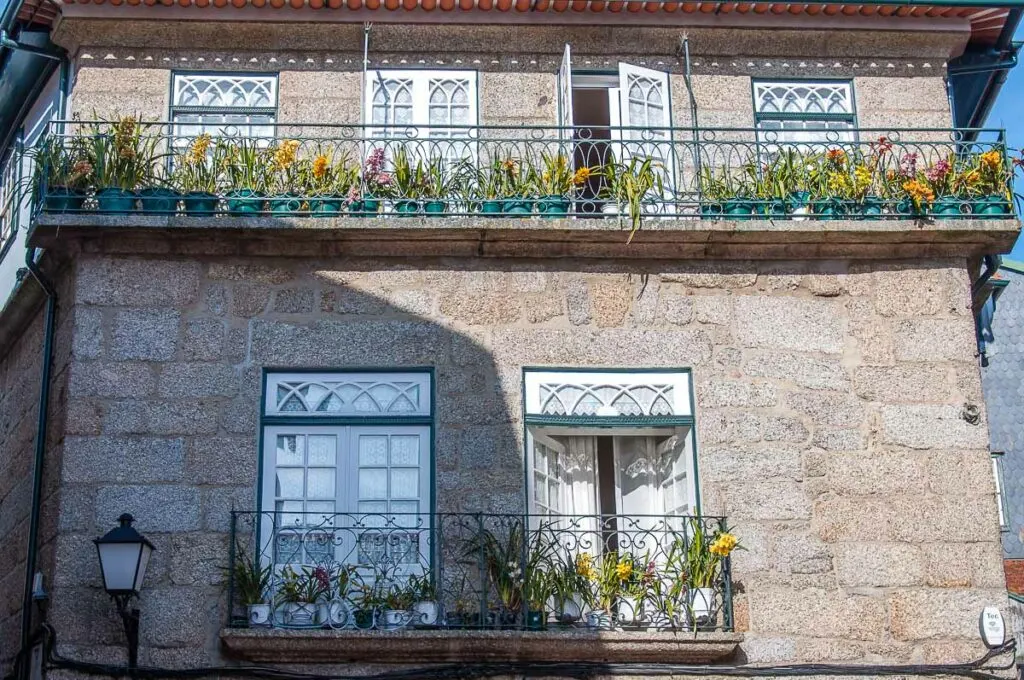
That’s it! You’ve done it!
You’ve seen Guimarães and its most splendid historic, cultural, and natural sights in one busy day. Now, you just need to walk from the historic tanneries back to the parking lot or the train station. The walk is almost one kilometre long and should take you about 15 mins.
Start by walking west on Largo do Cidade towards Rua de Couros. Largo do Cidade turns slightly right and becomes Tv. do Rio de Couros. Stay on it for 140 m. Then, turn right onto Rua de Vila Flor. Turn right again to stay on the same street and follow it for 110 m. Turn left onto Avenida D. Afonso Henriques and follow it for 350 m.
At this point, you will reach Centro Cultural Vila Flor. If you have parked here, this brings to an end your one-day trip to Guimarães.
Otherwise, continue walking on Avenida D. Afonso Henriques for 190 m. Then, turn left onto Avenida D. João IV. After 120 m, you’ll see the train station on the right.
There is not much to do at the train station itself. However, the trains to Porto are heavily used by locals and tourists. So, try to arrive at least a few minutes before departure in order to get a good seat. Otherwise and depending on the day and the season, you may need to travel standing up for part of the journey.
Map of This One-Day Self-Guided Tour of Guimarães, Portugal
Here is the map of Guimarães pinpointing all the major sights and places of interest to discover in this beautiful city in Portugal!
I made it with Google Maps. So, you can use it just like any other Google map: you can zoom in and out, click to open the map in a separate tab, click on the different pins to see their coordinates and exact address, and calculate distances and directions from wherever you are in Portugal (or abroad) to Guimarães. You can also share this map on social media.
I hope that it will come in very handy during the planning stages of your trip to Guimarães.
1. Guimarães Train Station 2. Centro Cultural Vila Flor 3. Largo do Toural 4. Museum of the Martins Sarmento Society 5. Rua de Santo António 6. Largo dos Laranjais 7. Jardim do Carmo 8. Church of Nossa Senhora do Carmo 9. Statue of D. Afonso Henriques 10. Church of São Miguel do Castelo 11. Castle of Guimarães 12. Palace of the Duques of Bragança 13. Rua de Santa Maria 14. Town Hall of Guimarães (formerly Convent of Santa Clara) 15. Divina Gula 16. Praça de São Tiago 17. Largo da Oliveira 18. Church of Nossa Senhora da Oliveira 19. Padrão do Salado 20. Alberto Sampaio Museum 21. Jardim do Largo da República do Brasil 22. Largo Conde de Arnoso 23. Fonte do Campo da Feira 24. Igreja e Oratórios de Nossa Senhora da Consolação e Santos Passos 25. Penha Cable Car 26. Sanctuary of Penha 27. Church of São Francisco 28. Tanques de couros
Practical Tips about Visiting Guimarães in Portugal on a Self-Guided Tour
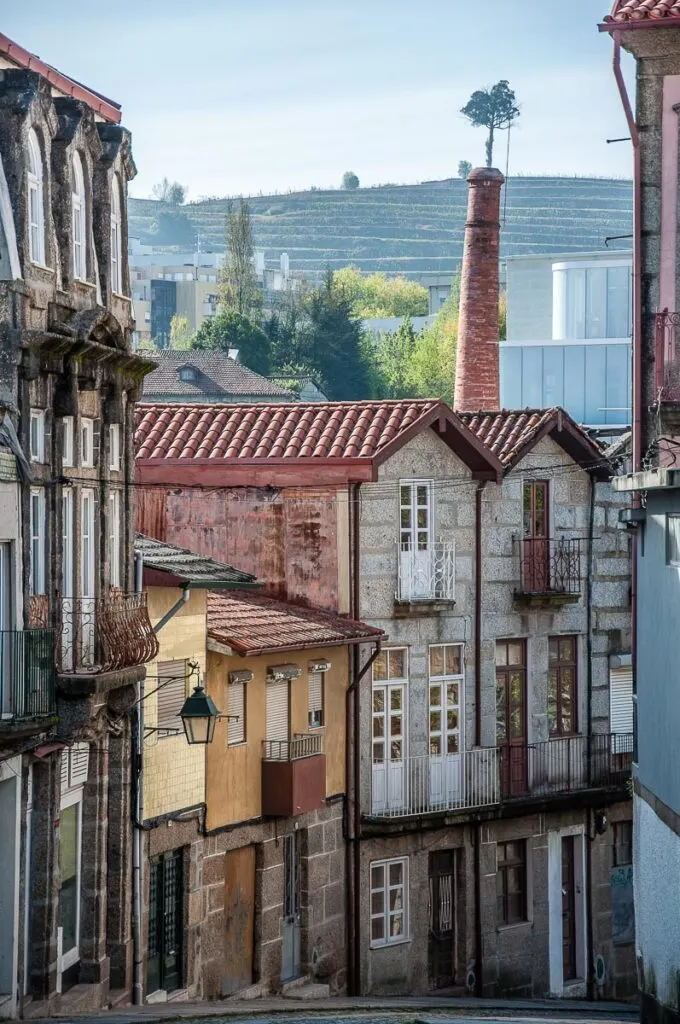
Guimarães is a truly lovely city to visit in the north of Portugal. Small, compact and with a beautiful historic centre, it’s easy to walk everywhere and see it all or almost all in a day.
To make your day trip to Guimarães as exciting and smooth as possible, keep in mind the following practical tips:
Order of sightseeing – feel free to adapt this one-day self-guided walking tour of Guimarães in Portugal to your specific needs. For example, you may decide to add more stops along the way, change the sequence of sights visited or even omit certain landmarks which may not be of interest to you.
Plus, you can easily split this self-guided walking tour of Guimarães over two days. This way you can spend the night in this beautiful Portuguese city, eat a relaxed dinner of local specialities, and enjoy its vibe in the evenings when the locals come out for a walk, meet up with friends, and relax after a long day.
Distances and walking times – Guimarães is a small city and everything is either right next to one another or just around the corner. The two longest stretches of walking are from the train station into the historic centre and then back. Both are about 10-15 minutes each.
Otherwise, the distances between the different sights on this self-guided tour of Guimarães are on average around five minutes. In the historic centre, there is something to see and do at every step, so walking doesn’t feel tedious and time flies quickly.
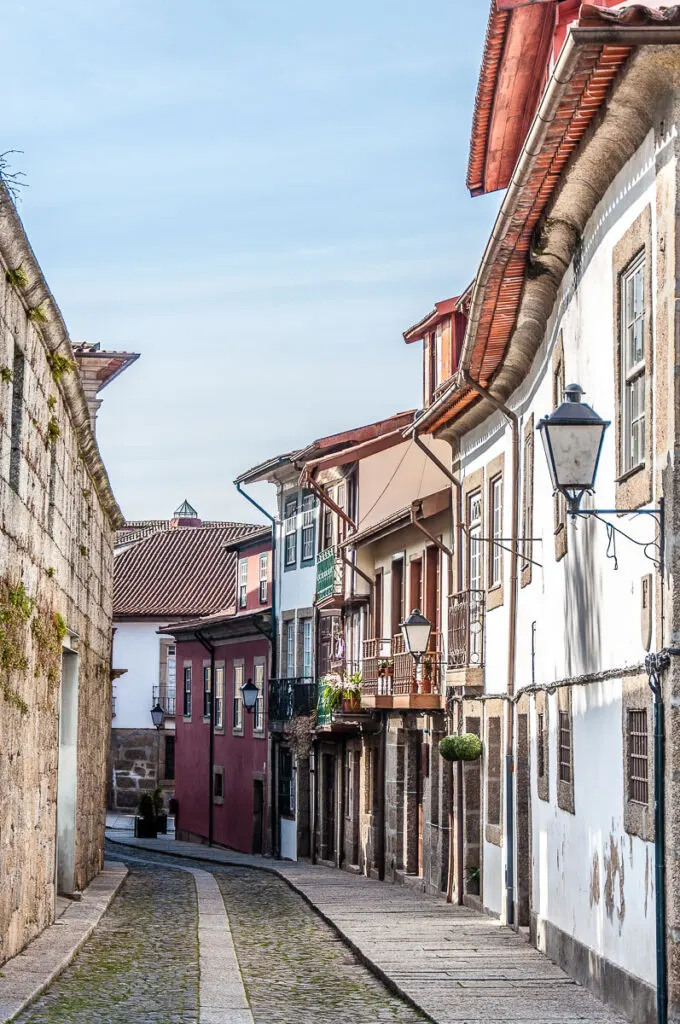
Elevation – while the historic centre of Guimarães feels rather flat and it’s very easy to navigate on foot, there is a gradual elevation. The most pronounced slope is from the Largo dos Laranjais up to the Castle of Guimarães on top of the Colina Sagrada – the Sacred Hill.
Walking up there won’t leave you exhausted but on a hot sunny day, you may find it more taxing to navigate. Take it as easy as you need. Plus, a bottle of water and a sun hat will come in very useful.
Avenida D. Afonso Henriques – the long residential street which connects the train station to the historic centre – also has a somewhat steepish dip. This is mostly felt on the way back to the station when you are rushing to catch your train after a day of sightseeing.
Historic surfaces – many streets in town are either cobbled or covered with thick stone slabs. Ideally, wear appropriate shoes that support the ankles, have a good grip, and when it’s hot, don’t allow your feet to slide inside them.
Energy levels and skincare – keep hydrated and sated at all times, especially on a hot sunny day. Guimarães’ small sunlit squares as well as the Colina Sagrada are easy spots to get a sunburn. Bring a water bottle (or get one from the many small shops in town), feast on the local delicacies, and stay out of the sun during the hottest hours of the day.
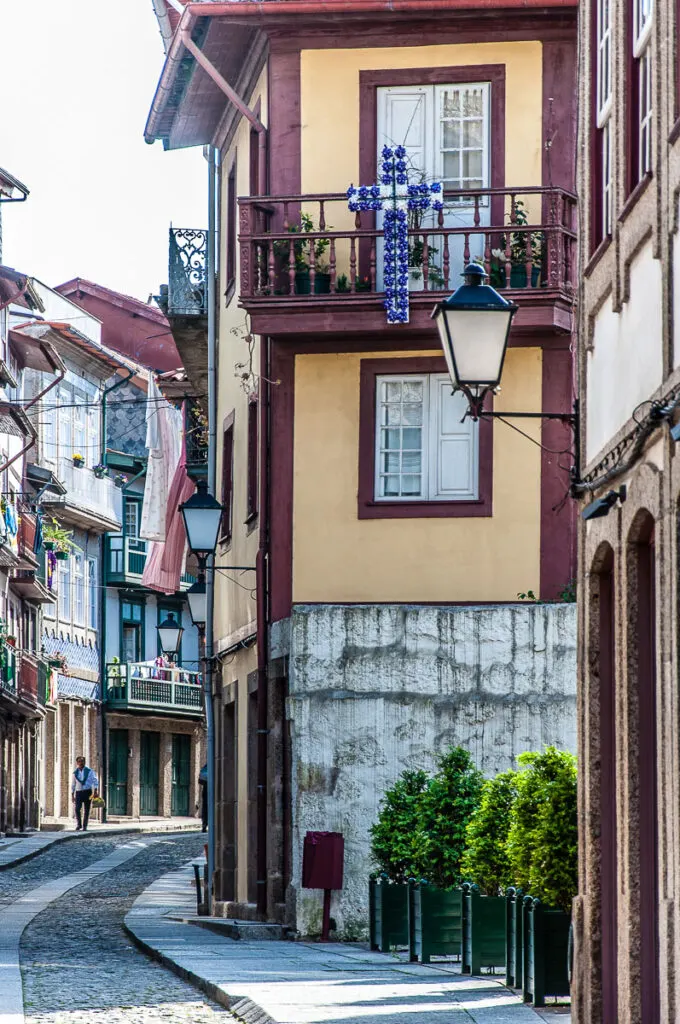
Respect and awareness – Guimarães and its main sights are emblematic for the whole of Portugal. The historic centre of the city is a UNESCO World Heritage Site and the whole city plays a seminal role in the country’s and nation’s creation myth. The Colina Sagrada with the hilltop Castle of Guimarães is a very special place for all Portuguese people.
In addition, this is still a very traditional society with strong religious traditions. Showing respect and certain decorum when sightseeing and especially, when visiting the churches in town is really appreciated by the locals.
Visiting with kids – Guimarães is easy to navigate with kids in tow. The historic centre is mostly pedestrian and the whole city has a nice and relaxed vibe to it. While there are no specific kids’ attractions here, sightseeing is not cumbersome.
The main sights and museums can be explored as slowly or as quickly as you want. Then you can head to the cable car and enjoy a nice walk on top of Monte da Penha. Or you can stay in town and relax in the sunlit squares flanked by restaurants and cafes with outside tables.
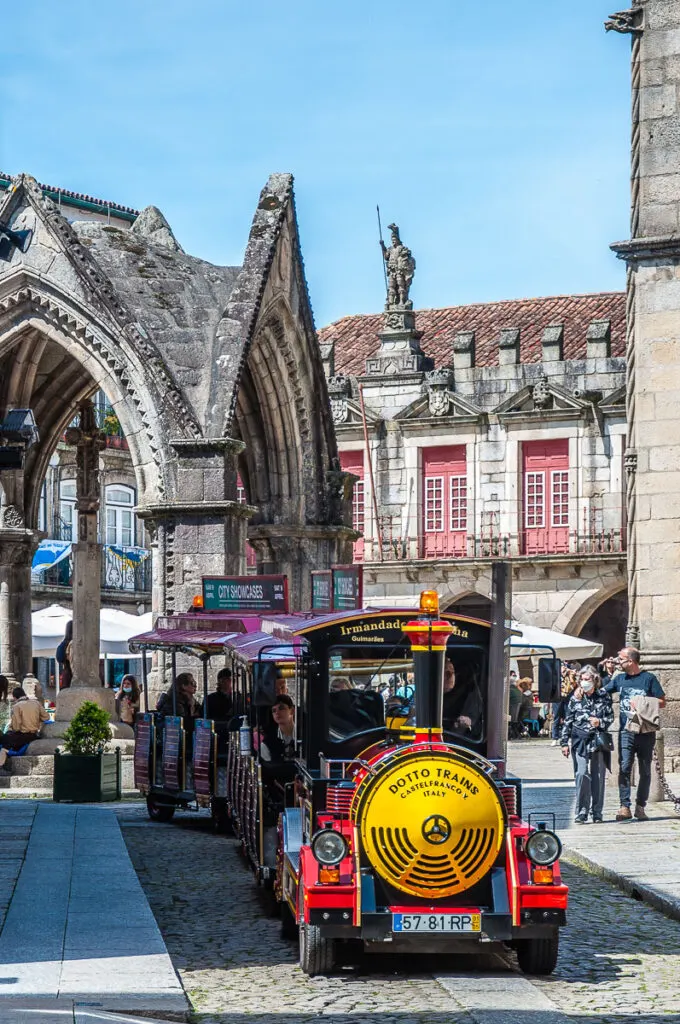
Opening times – always check current opening times before your visit. Where possible, I have provided links to the official websites of the different sights in Guimarães.
For example, while the Castle of Guimarães and the Paço dos Duques de Bragança are, in principle, open every day (with some limited exceptions), the Alberto Sampaio Museum and the Museum of the Martins Sarmento Society are closed on Mondays.
Penha Cable Car has seasonal opening times. During the low season, it remains closed for most of the week. To avoid disappointment, check its current times before making plans to visit.
Train times – if you are visiting Guimarães on a day trip from Porto, bear in mind that in the afternoon there may be a wait of two hours between return trains. Plan your exploration of the city around train times as it’s not fun arriving back at the station with too much time to spare before the next train.
Organised tours – if you don’t feel like travelling on your own and doing it all by yourself, then you can book a guided tour to take you to Guimarães. Further below I have referenced some of the best tours from Porto. Otherwise, you can click to see the full list.
How to Reach Guimarães from Anywhere in Portugal
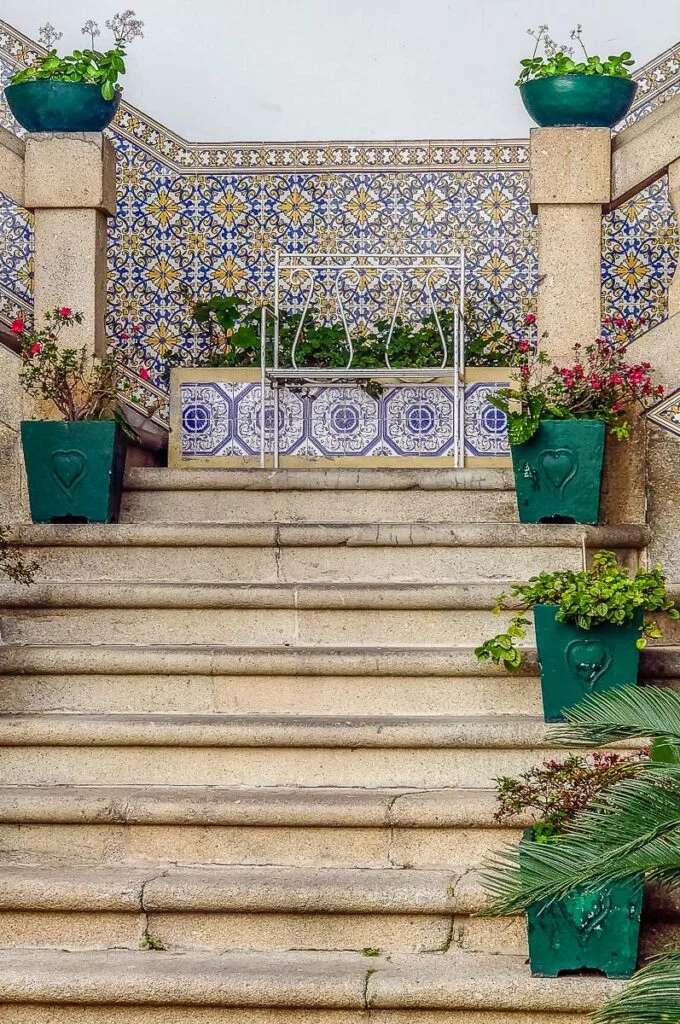
It is very straightforward to reach the city of Guimarães from anywhere in Portugal either by car or public transport.
Here is how to proceed:
By Car:
Use Google Maps or an alternative GPS app to get specific directions from your point of departure to the city of Guimarães.
Here are some average travelling times to give you an idea of how long it will take you to drive to Guimarães from some of the most important Portuguese cities:
from Braga – 20-35 mins, 24 km away;
from Porto – 35-55 mins, 54 km away;
from Coimbra – 1 h 30 mins – 2 h 20 mins, 171 km away; and
from Lisbon – 3 h 10 mins – 4 h 30 mins, 363 km.
While the historic centre of Guimarães is mostly pedestrian and vehicle traffic in it is strictly restricted, there are many car parks around the city.
I suggest using the car park at Centro Cultural Vila Flor in order to follow from the very beginning the one-day self-guided tour of Guimarães described in this blog post.
However, there are many other car parks in the city, so make your choice depending on your specific travel plans. For specific information, have a look at the website of the local provider Vitrus Ambiente. It’s in Portuguese, so you can use Google Translate to get an idea of what it says.
By Train / Bus:
Portugal has a well-organised railway system operated by the national train company Comboios de Portugal. Trains running at regular intervals throughout the day connect Guimarães to the country’s largest cities.
Porto to Guimarães – trains leave from Porto’s São Bento station and also stop at Porto’s Campanhã station. The journey lasts about 1 h 12 mins or slightly longer depending on the time of the day. It’s quite tedious as the train stops at over 20 small towns along the way. Yet, the tickets are very inexpensive and it’s a very easy day trip to make. You can check the timetable at this link.
There is also a shuttle bus connecting Porto Airport directly to the city of Guimarães. This way, you can head to Guimarães as soon as you land instead of first having to take a taxi or the underground to Porto. You can check the current timetable of the airport shuttle bus at this link.
Lisbon / Coimbra to Guimarães – trains leave from Lisboa Santa Apolónia and Lisboa Oriente train stations and on average take about 4 h to 4 h 20 mins to Guimarães. Coimbra is a stop on the same railway line. You can check the timetable at this link. You’ll notice that there is a limited number of direct trains per day, so instead, you may want to travel first to Porto or Braga and then take a train (from Porto and Braga) or bus (from Braga) to Guimarães.
Braga to Guimarães – you can reach Guimarães from Braga either by train or by bus. By train, you will need to take the train headed to Porto and then change at Lousado where the train arriving from Porto and headed to Guimarães also stops. Alternatively, you can take a bus connecting Braga directly to Guimarães. Travel time by bus is about 45-50 mins. You can check the timetable at this link.
By Organised Tour:
If you are short on time and want to see the maximum within a day or if you enjoy having it all organised for you, then there are many guided tours you can choose from. Usually, in addition to Guimarães, they also take in the nearby city of Braga and the Sanctuary of Bom Jesus do Monte.
A knowledgeable and friendly guide will escort you from nearby Porto to these two iconic Portuguese cities and the famous sanctuary giving you in-depth information about this corner of Portugal, its history, and traditions.
Here is a selection of the best day trips from Porto to Guimarães, Braga, and the Sanctuary of Bom Jesus do Monte. Click on the photos for more details and to book now:
In Conclusion
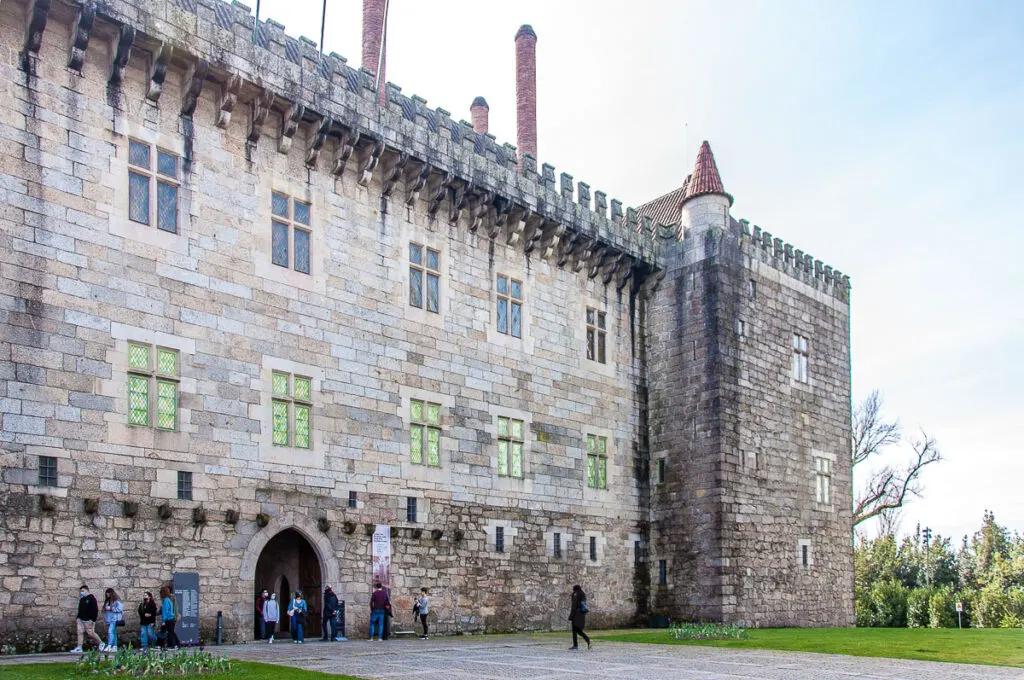
Here you have it – a one-day self-guided tour of Guimarães in Portugal. Known as the cradle of the nation, this small city in the north of the country has a beautifully preserved medieval centre, a handful of must-see landmarks of national value, a cable car to the top of a small mountain, and some of the tastiest desserts this side of the Iberian Peninsula. Plus, it’s a UNESCO World Heritage Site.
As such, Guimarães has all the requisites for a wonderful day trip in Northern Portugal – history, nature, and good food.
So, in case this sounds like a place you would like to experience for yourself, I hope that this blog post will come in very handy. The detailed self-guided tour I share with you was personally tried and tested on location by me and my family in the run-up to Easter this year. It covers Guimarães’ main sights and includes a nice walk throughout the historic centre as well as a ride on the city’s cable car.
Plus, to make your travel planning even easier, I have also included a list of practical tips as well as helpful information on how to get to Guimarães by public transport and by car from the largest Portuguese cities.
I hope that all these details will come in very handy and that you will have a great time visiting the north of Portugal!
Enjoy Guimarães!
Now, get ready quick for your visit to Guimarães in Portugal!
- Consult these guidebooks.
- Buy plane tickets.
- Book train tickets, bus tickets or rent a car.
- Research accommodation.
- Select local tours and activities.
More Helpful Travel Info for You
Best of Portugal: Photos of Guimarães, One Day in Porto, Photos of Porto, One Day in Aveiro, Photos of Aveiro, Photos of Braga, Sanctuary of Bom Jesus do Monte, Best Portuguese Desserts and Pastries
Best of Italy: Venice, Lake Garda, Veneto, Lombardy, Emilia-Romagna, Marche, Friuli Venezia Giulia, Trentino, Italy with Kids, Italy for Foodies, Day Trips in Italy, Hiking in Italy, Christmas in Italy
Best of England: London, Kent, Dorset, East Sussex, Days Out in England
Travel: Travel Resources, The Joy of Travel, Safety Tips
Thank you for reading! Please, leave me a comment, pin the images or use the buttons right at the top and at the end of this blog post to share it on social media.
For more useful information like this, please, like my blog’s page on Facebook and subscribe to my strictly no-spam newsletter.
Pin This Blog Post!
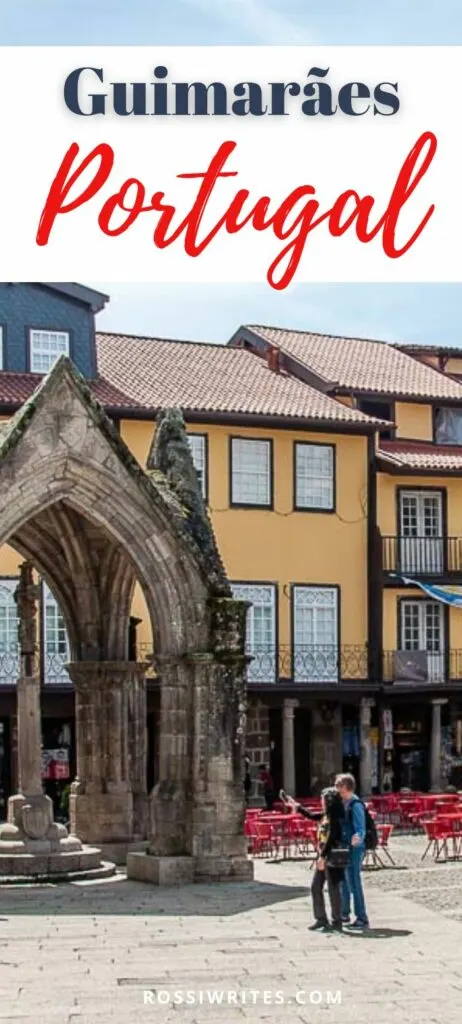
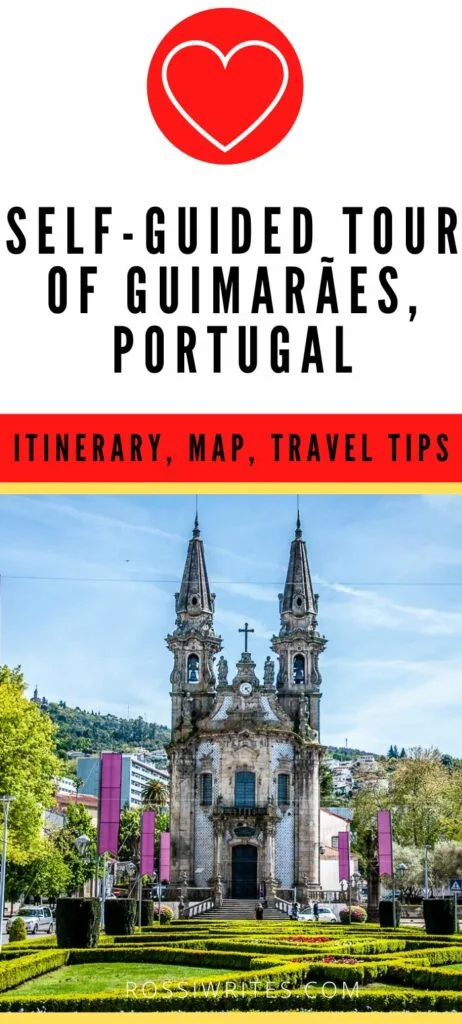

Pam
Thursday 15th of December 2022
Thank you for this your other main sites in Guimaraes. I was here briefly on a tour but came back to visit further. This was very helpful.
admin
Sunday 1st of January 2023
Thank you very much for your kind words! I hope you had a lovely time in this beautiful Portuguese city! Best wishes,
Rossi :)
Christine Witton
Sunday 8th of May 2022
Thanks once again Rossi for a great travel guide to Guimares. I had your earlier guide and this helped to fill in the blanks. A question I have is do you think it better to go from Porto to Braga first and then travel ton to Guimares or to do the reverse given that trains in the afternoon from Guimares are limited. We would spend at least three days in each city. Also do you have any information on the sighseeing road train you showed in the pictures?
admin
Monday 9th of May 2022
Thank you for your kind words, Christine! We went to Braga first, on a Thursday, and then to Guimaraes on Saturday. Both times we travelled directly from and then back to Porto. If I understand your question correctly, you are considering travelling to Guimaraes from Braga or to Braga from Guimaraes(?!). If I didn't get it right, just let me know. If you are worried about trains and timetables, have you considered travelling between the two cities by bus? This way you won't have to change trains in Lousado but travel directly from one to the other. In reply to your question: we saw this little train around the historic centre but we didn't have the time to get on it. As far as I understood it's operated by the Brotherhood of Penha (Irmandade da Penha) - the Sanctuary on top of Monte da Penha that overlooks Guimaraes. I found these links about the train online: https://www.penhaguimaraes.com/pt/artigo/118 and https://www.allaboutportugal.pt/en/guimaraes/outdoor-activities/mini-trem-turistico-da-penha. The information is very sparse but my understanding is that the train connects the historic centre to the sanctuary. There are many lovely places to see in this part of Portugal, especially if one has the time to explore. Our original plan was to visit Peneda-Geres - a beautiful natural park with lots of hikes, waterfalls, and ponds. Unfortunately, the only way to reach it was to hire a car and we didn't want to deal with a rental car for one day only (as everything else we wanted to see was reachable by train). Otherwise, near Porto and Braga you also have Barcelos, Viana de Castelo, Aveiro, Lamego, the River Douro with its vineyards, etc. Really, so much to see. Have a wonderful time in Portugal! :)